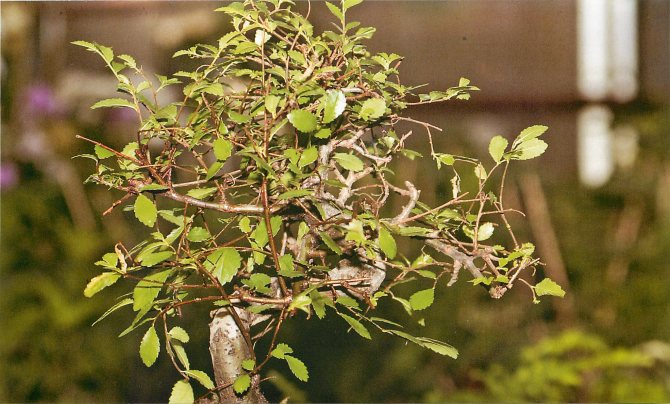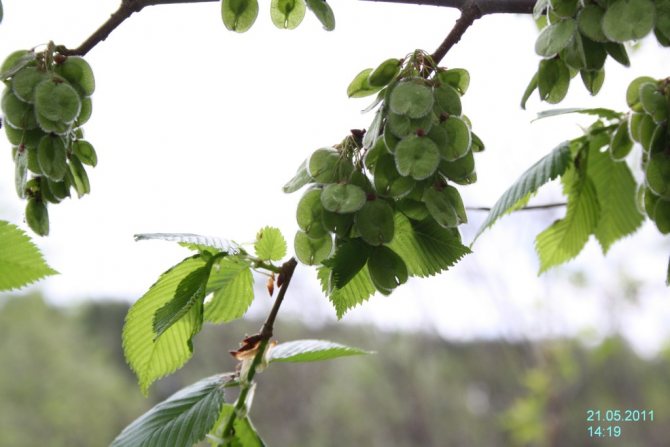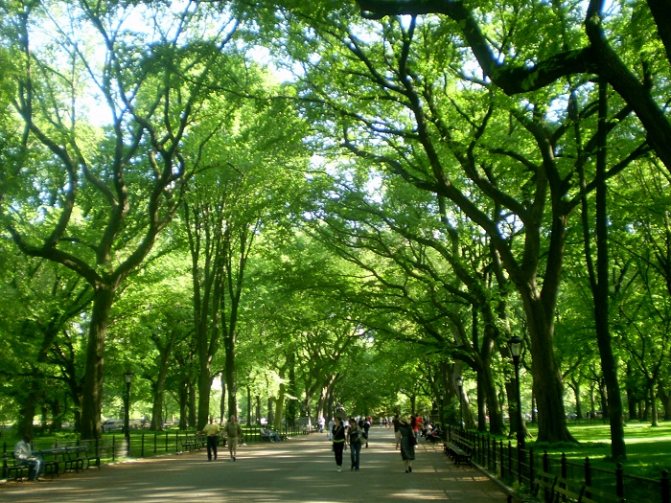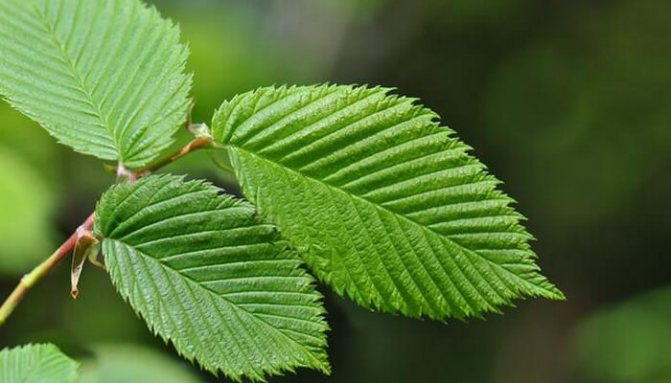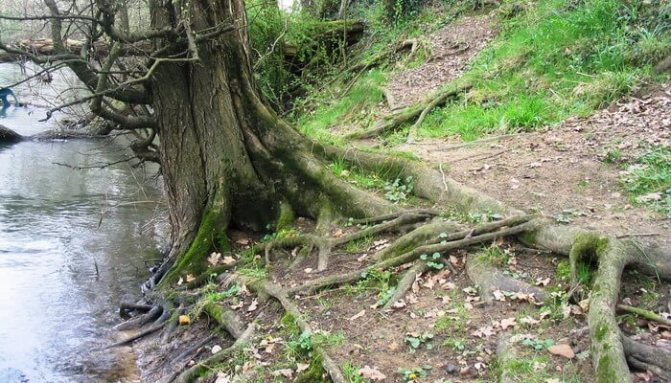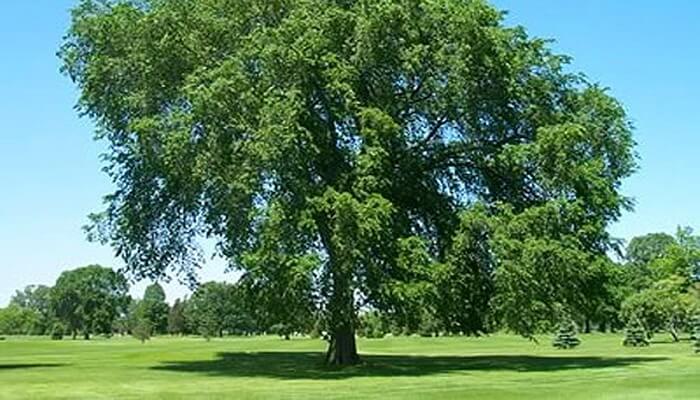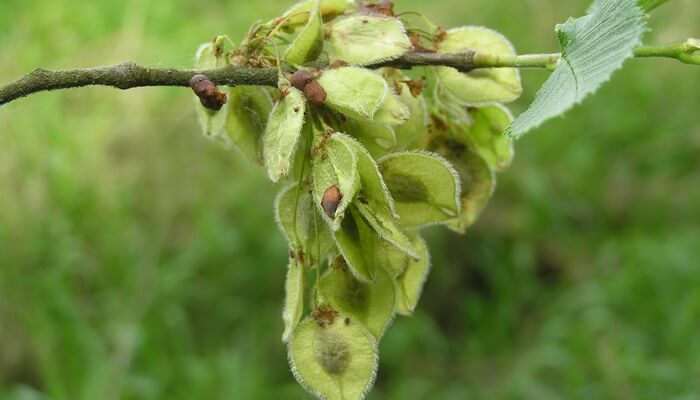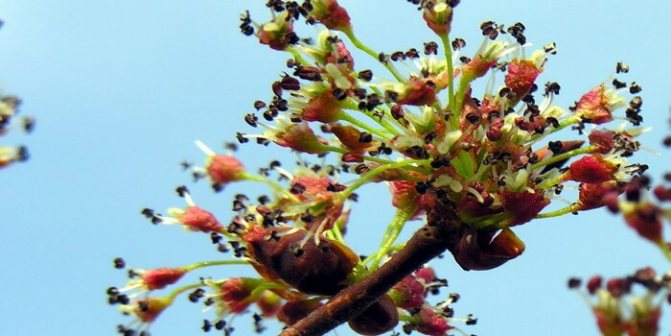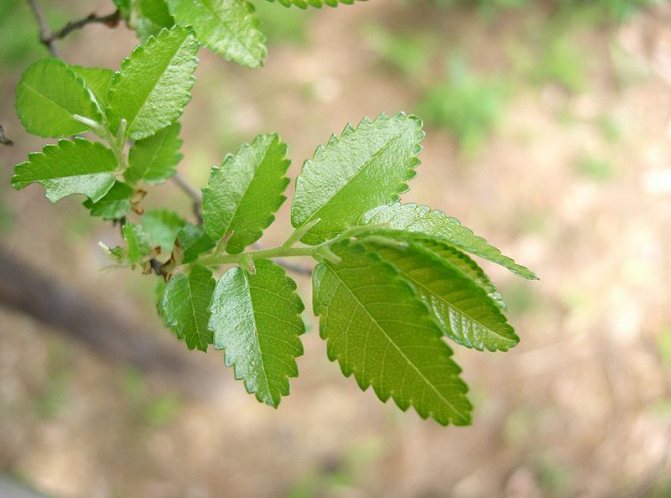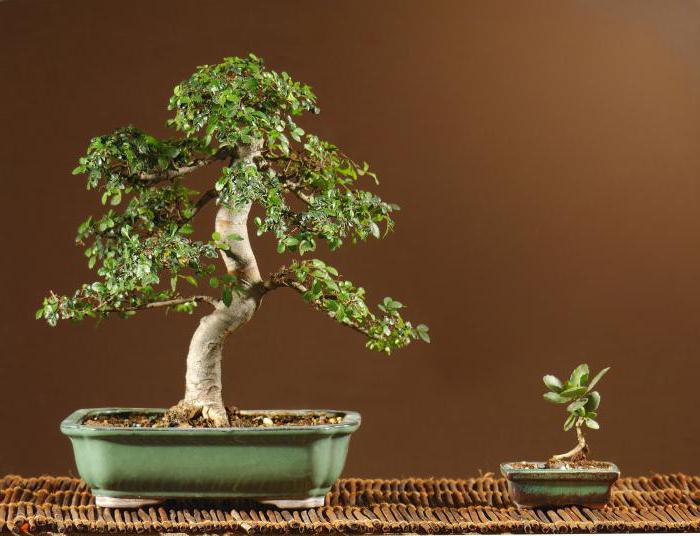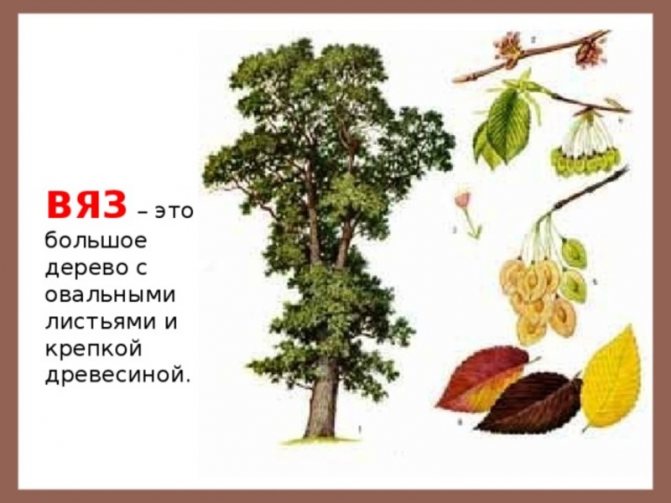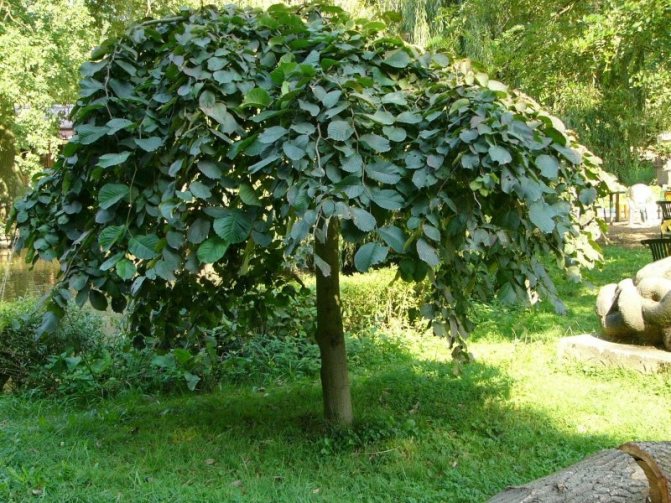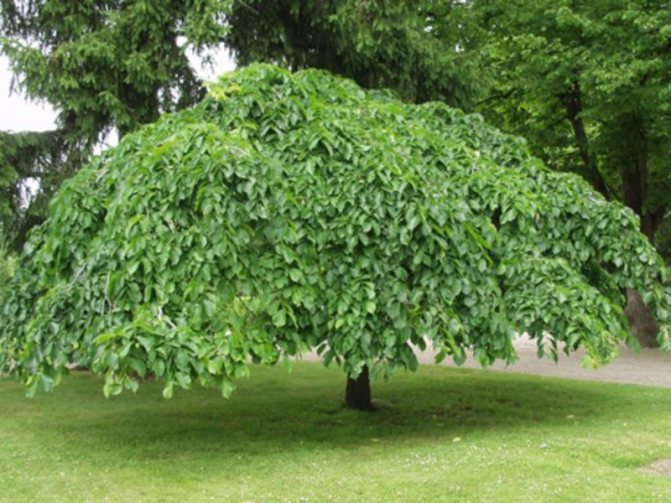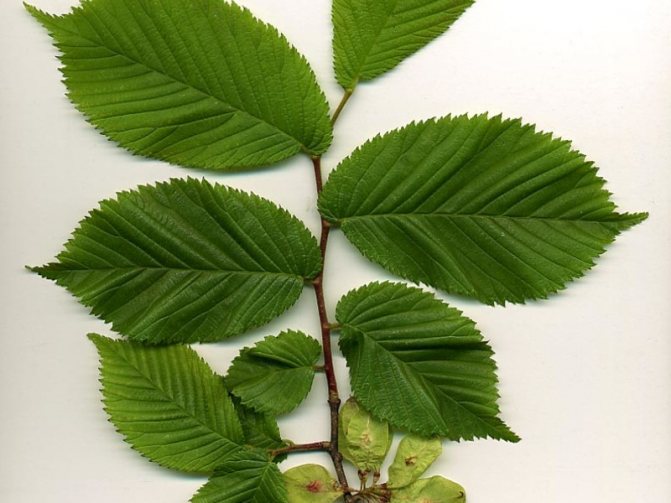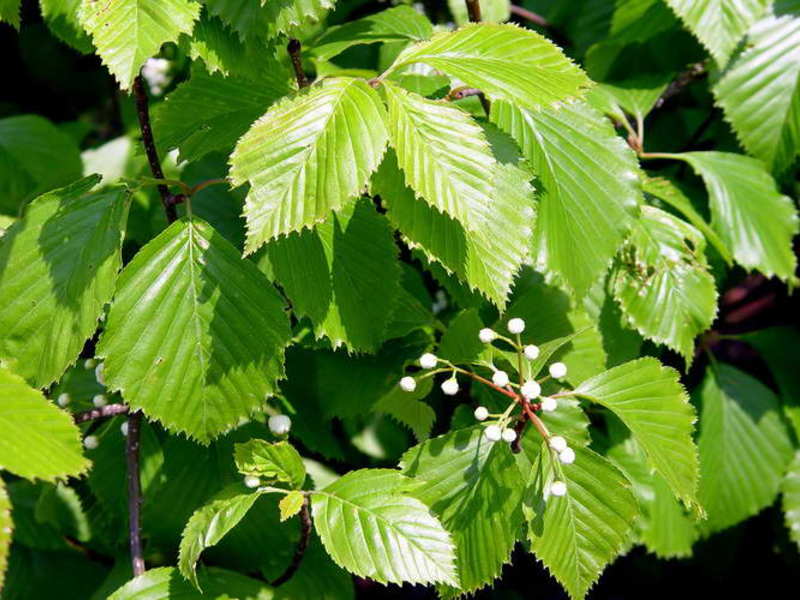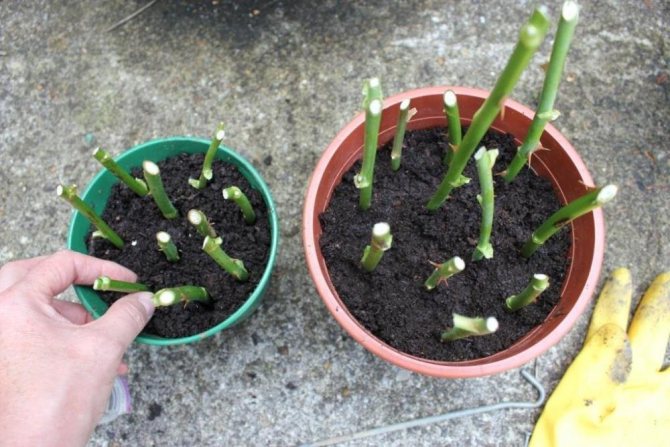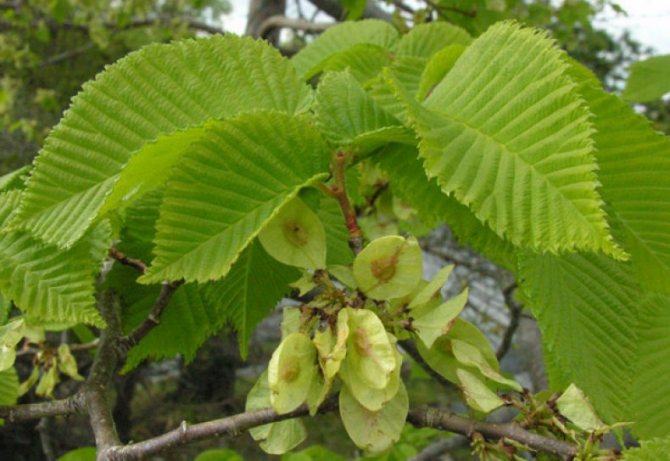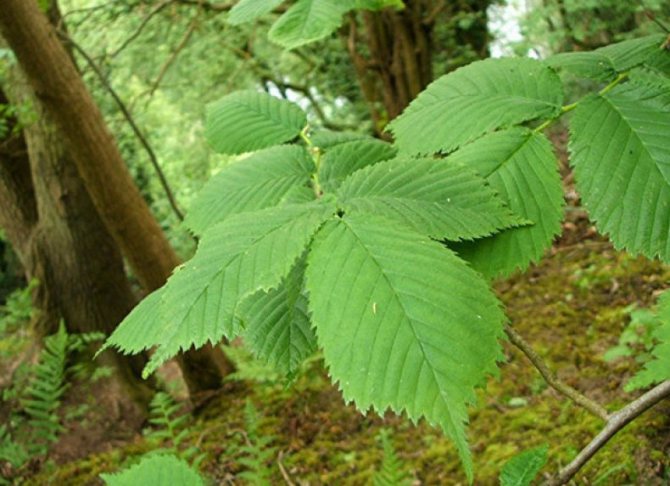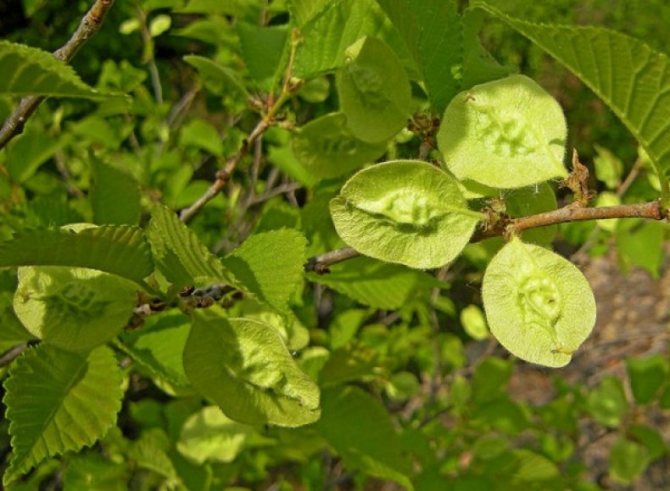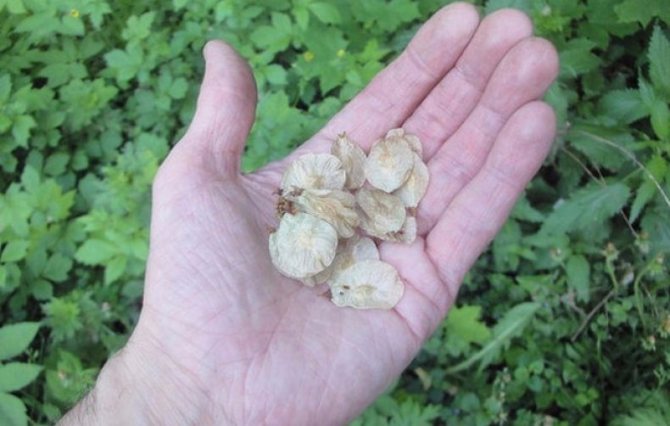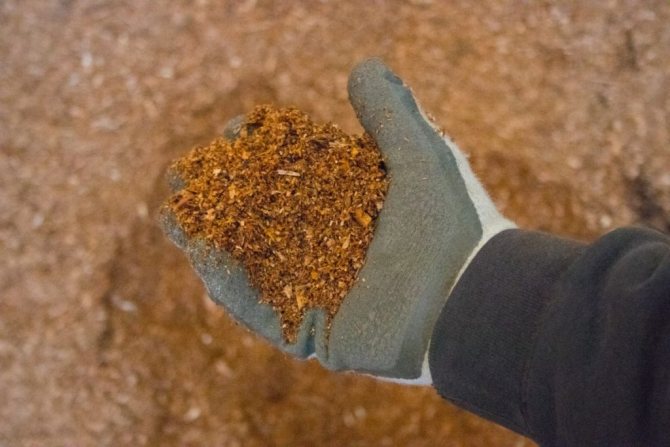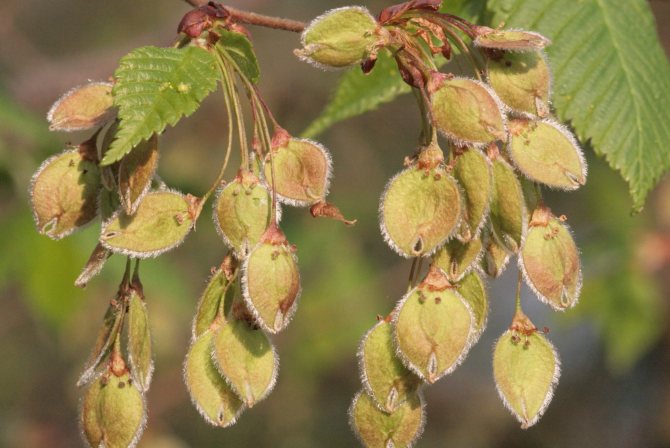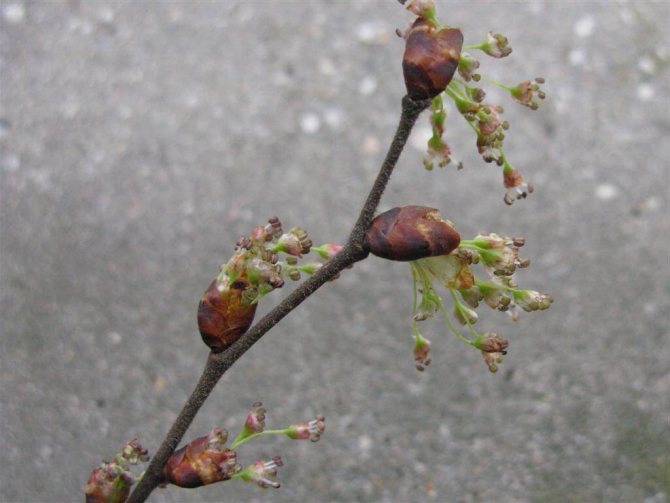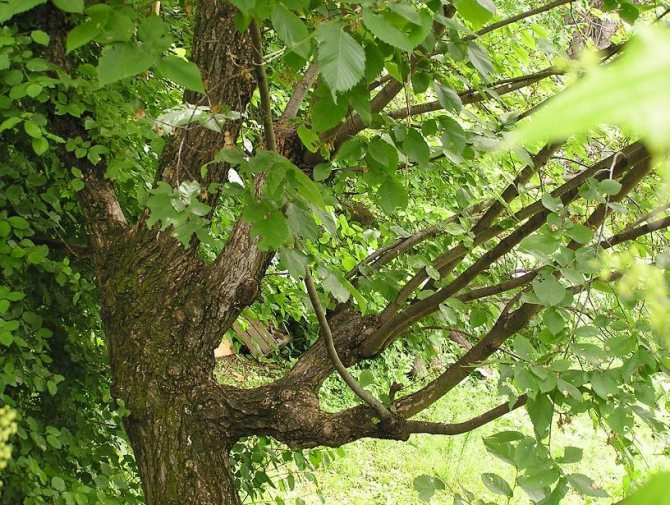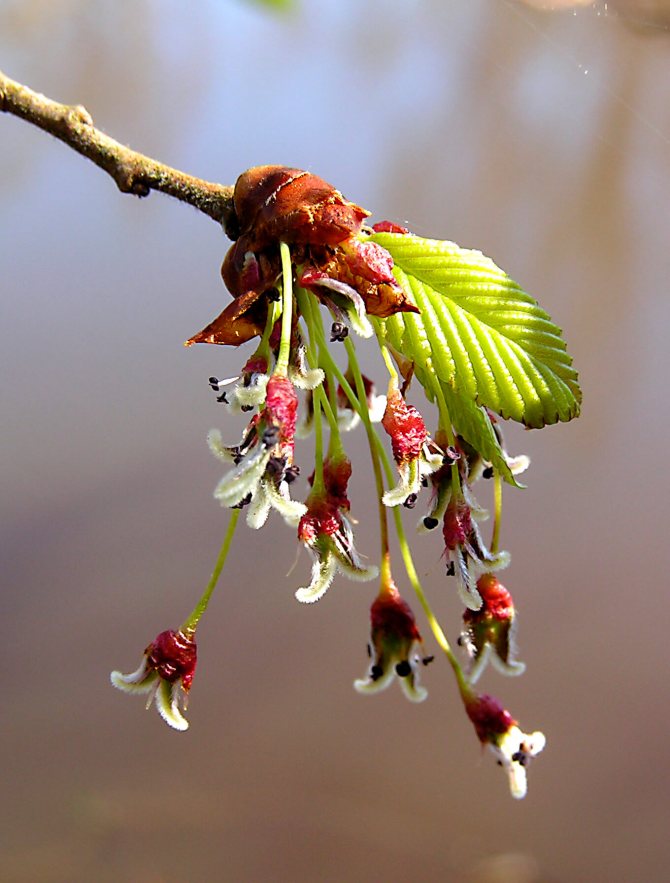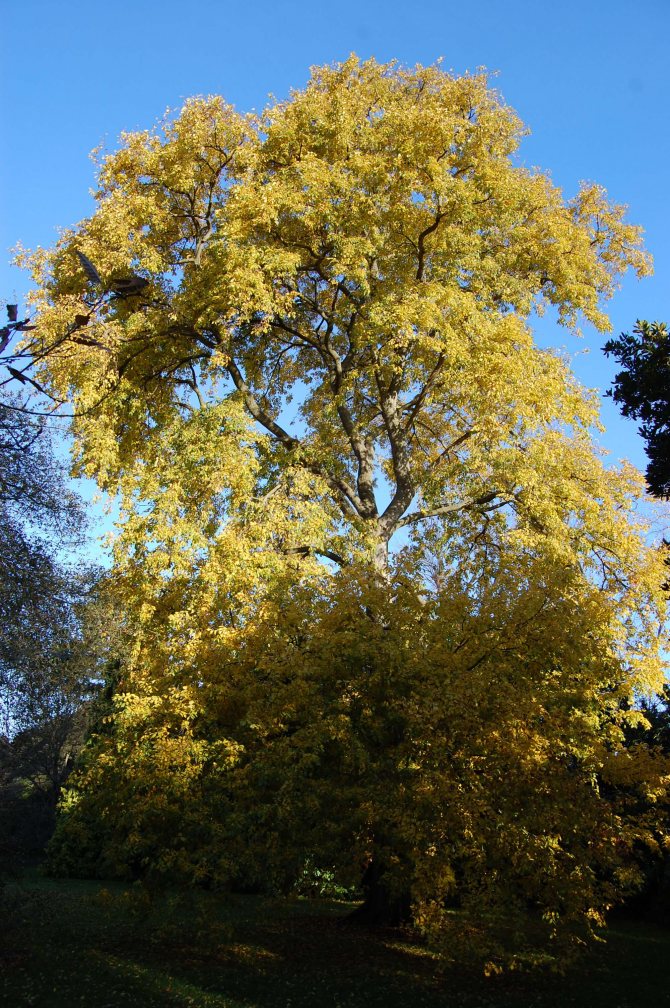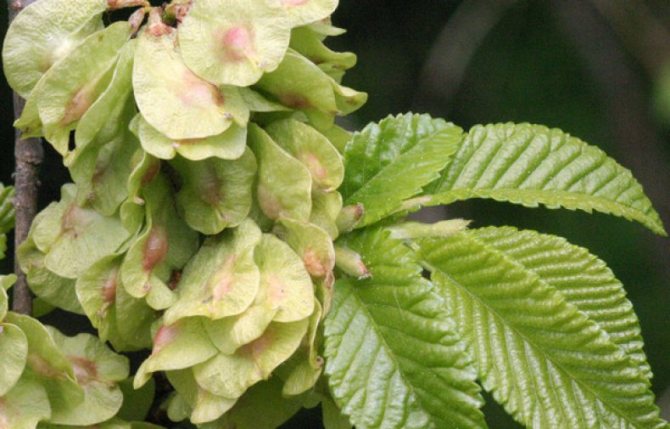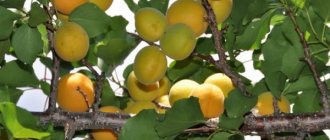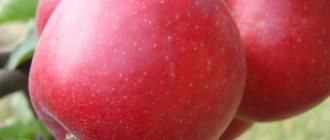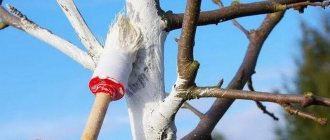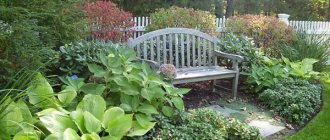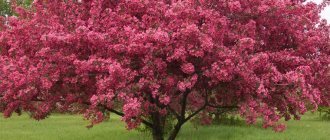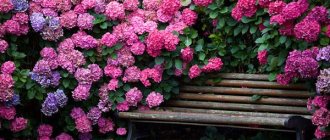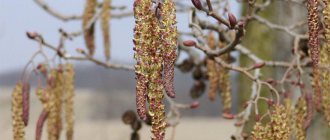The genus has 16 species that grow in Europe, Asia, and in the mountains of Asia.
As a rule, these are large trees with an elliptical or rounded, spreading crown; with alternate, simple, large, unequal leaves. The elm blooms before the foliage blooms. Elm flowers are small, inconspicuous. Nuts ripening 2 weeks after flowering.
Elm does not tolerate shading, but itself gives a thick shade. The growth is relatively fast. Requires fertile soil for growth, but also tolerates arid conditions.
Elm tolerates pruning well, is durable under good conditions, and is often damaged by diseases and pests. It has been used for a long time in landscaping. It has been introduced into culture since ancient times and has many garden forms.
Ornamental trees and shrubs: a description of the rough elm
The elm is about 5 m high. Many branches grow in all directions. The crown looks spreading and voluminous. Closer to the top, it takes on a flat shape. The foliage is dense and dense. The shape of the leaf plate is not symmetrical. Its surface has a rough texture. Large leaves grow on small cuttings. The large volume of foliage creates significant shade. With the arrival of autumn, its green tint is replaced by yellow-orange.
The rough elm has a dense, uneven crown
Young specimens are characterized by a high growth rate. With age, its activity slows down. At the end of spring, the flowering period begins. A lot of inflorescences are formed on the tree, consisting of miniature flowers of a light shade. A short time later, elliptical fruits appear.
The elm has a strong and strong root system. Lateral roots grow on the surface of the earth
The tree can be grown both in single and mixed plantings. It is able to grow in the shade of other trees. The species of pendula is the most shade-tolerant.
Properties and advantages of wood
Elm wood is practically non-rotting even at high humidity levels. Because of this feature, the tree became popular in Europe - pipes for water supply were made from its trunks. For the construction of the very first London Bridge over the Thames, the supports were created from elm wood. It is also known that in tsarist Russia, durable arcs, runners and shafts for horse-drawn transport were made from it.
By its properties, elm wood resembles oak - the material is very viscous and difficult to split. Although it is inconvenient to process it with cutting tools (especially without electrical devices, it takes a very long time to plan it), but it is remarkably polished and adheres well. Before finishing with this wood, its pores must be filled with a primer. During drying, the wood almost does not crack - according to these properties, it does not differ from oak.

Elm wood table top
In the modern world, smooth elm due to the moisture resistance, hardness and elasticity of its wood is cultivated for the subsequent production of furniture, the creation of floor coverings, and use in the engineering field and in shipbuilding.
Coarse elm pendula: growing
The plant can be propagated by grafting. The height of the stem affects the size it will reach in the future. The tree is not demanding for daylight. It can be grown in partial shade or shade.In joint landings, it is important to maintain a distance. Elm does not tolerate a tight fit. To protect it from dangerous pests, it is not recommended to plant next to:
Elm grows well in light and loose soil that does not impede the circulation of air currents. The soil must be fertile. Mineral complexes and organic matter can be used as fertilizers. The rough elm can withstand short-term stagnation of water.
Elm can be called a slender, powerful and stately tree. Its domed crown is immediately striking. This tree is similar to oak, just as large, tall and centuries old. What does an elm look like, its description and photo, what fruits does this giant have?
This tree has several names - elm, birch bark, elm. It is a deciduous tree of the elm genus, the elm family. There are about 40 species of elm trees around the world. For the first time, such trees appeared more than 20 million years ago in Central Asia. Gradually, the plant spread further to other countries. Most often, it grows in deciduous forests and other natural areas with a temperate climate.
Decorative application
Karagach is excellent for urban conditions: it grows quickly, it is drought-resistant. Looks beautiful in joint planting with acacias and conifers. It can be used for quick landscaping as well as hedges. Decorative and common forms of elms are used for the arrangement of parks and gardens. Some varieties look spectacular in the central places of grassy lawns. It is better not to plant flowering plants directly under the elms, as their crowns form a deep shadow. Due to their shearing tolerance, elms are used in the Japanese art of growing bonsai dwarf trees.
Interesting fact: the wood of an elm tree, being in the water, does not rot. Therefore, in the old days it was used to make water pipes and supports for bridges. Elm has also found its use: in the production of furniture, its wood is highly valued for its beautiful pattern and high strength.
November 28, 2011
We devote this article to lovers of large-size owners and those who are just about to join them. Although there are very miniature plants in the elm family, ideal for bonsai compositions, most trees are of solid size.
Adult elm
can reach 16 meters in height, and its crown grows up to 10 meters in diameter. Shrub versions of this plant also reach up to 6 meters.
The main charm of an elm tree is its absolute unpretentiousness. This tree loves sun or partial shade. At the same time, it calmly tolerates dry soil or prolonged rains, wind and even severe frost. Adult plants do not even care about temperatures up to minus 50 degrees - they can freeze a little at the edges, but they quickly recover.
What does an elm look like?
Elm is considered long-lived tree
because it can live for over 300 years. Has a large elliptical or rounded crown shape. The barrel diameter can reach
2 meters
... Sprawling branches have dense foliage. The leaves are large, unequal and simple. The elm blooms before the foliage begins to bloom. The flowers are small and inconspicuous in appearance, collected in bunches. After flowering, winged nuts appear on the branches, which ripen after flowering in a few weeks. They contain seeds that quickly lose their germination. The tree bears fruit very abundantly, on average up to 30 kilograms per year. The fruits have the same appearance and may differ only in size.
It is considered very valuable. It is dense and hard, reminiscent of a European nut. Wood is considered a valuable species. It is an excellent material for the production of furniture. The barrel has a smooth surface that lasts for many years. The bark can flake off only due to tree disease or old age.With the appearance of cracks and furrows, the bark becomes a deep brown color. The leaves and bark of the tree are used to make medicines.
The elm tree has a strong and powerful root system. It can be on the surface of the earth or go deep into the depths. The trees are fast growing and in a year they rise up to half a meter in height and 30 cm in width. They tolerate very well low temperatures up to -30 ° C.
Elm diseases
Trees are prone to the so-called Dutch disease. Its causative agent is the fungus Ophiostoma ulmi, which spreads through bark beetles. First of all, weak and young elms are under threat. The disease proceeds in an acute or chronic form - in both cases, damage to the conducting systems and blood vessels of the tree occurs. You can diagnose the disease by cutting off its branch. The wounded vessels look like brown spots or rings. During illness, the degree of vascular occlusion progresses, the tree begins to dry out.
In its acute form, the elm will completely dry out in a matter of weeks. In the case of a chronic form, the tree will live for several more years. Alas, an elm infected with this disease cannot be saved in any way - at one time in Holland, because of it, up to two-thirds of the tree plantings of this genus died.
To prevent the disease from spreading to other trees, preventive and quarantine measures are taken. Healthy individuals adjacent to the affected plant need to be injected with a fungicide. In the presence of accrete roots, it is urgent to chop them off. This infection spreads most quickly in favorable conditions for the fungus - that is, in humid areas with moderate temperatures.
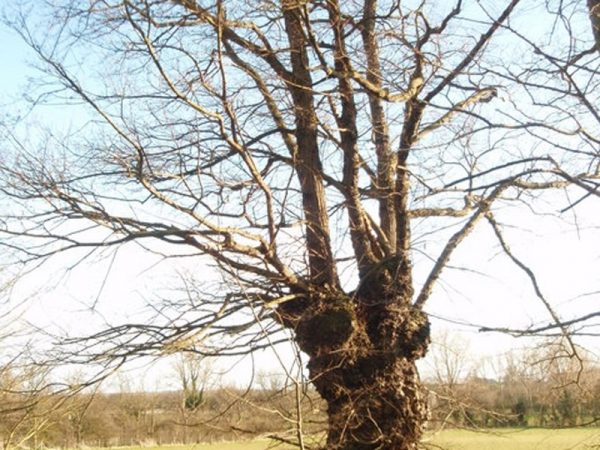

Defeat by Dutch disease
Where does it grow and when does it bloom?
Elm trees grow well on fertile soils
and with proper care they reach large sizes. However, in natural conditions they can easily endure drought and floods, they easily endure severe frosts. Most often, elms grow on the territory:
The powerful crown of these trees retains dust well. It often serves as a planting fence. A large crown with dense foliage can often be seen in many parks and gardens in cities. In their natural environment, elms are often found in deciduous forests, along the shores of lakes and rivers. They help to create clean plantings.
The flowering period begins very early, in the month of March - April. Small and inconspicuous flowers, collected in bunches in the leaves, are easily pollinated by the wind. The ripening period of the fruit depends on the climatic conditions. Most often they ripen in April - June. An adult tree begins to bear fruit at the age of 7-8 years.
Description
The elm is a large deciduous tree that can grow up to 40 m. At this height, the trunk diameter reaches 2 m. There are species in the genus that grow in the form of shrubs. The crown of elms can be wide, cylindrical or spherical. The branching is sympodial, that is, the top of the main branch (axis) stops growing at some point, and its place is taken by the lateral branch, growing in the direction of the main axis, over time, a kind of ladder along the trunk is obtained.
The color of the bark is mostly brown. In young specimens, the bark is smooth, coarsens with age, longitudinal cracks appear on it, and in some species slugs. The root system is powerful, often without a taproot. The leaves are arranged alternately, two-row-mosaic, from which the crown of elms practically does not transmit light and forms a thick shadow at the foot. Leaves 5 to 20 cm long, have short petioles. The outlines and sizes of the leaves can be different, they form a kind of lace - the so-called ligature. With the arrival of autumn, the leaves turn into an elegant yellow color.
Botanical illustration of the type species V. American (U. americana)
The elm begins to bloom early, in March-April.Small inconspicuous flowers, grouped in bunches in the leaf axils, are pollinated by the wind. The fruits ripen in April-June, depending on climatic conditions. The fruits are winged nuts, collected in groups. Elms begin to bear fruit at the age of 7-8 years. A large number of seeds ripen on each tree, which are carried by the wind and, once in moist soil, germinate in 5-7 days. Trees live up to 120, and some up to 300 years.
Common types
On the basis of some popular types of elms, many varieties and hybrids have been bred. Such plants can be seen in many gardens, squares and city parks. They are often used for landscaping streets. We will take a look at the most popular types of elm trees that can be found most often.
- this tree has a beautiful crown with spreading branches. Its bark is dark brown. The dark green elliptical foliage is smooth and jagged. With the end of autumn, it turns brown. This species perfectly tolerates frosty weather, shade and is drought tolerant. For rapid development, it needs fertile soil, which does not allow it to grow normally in urban conditions. Smooth or common elm grows most often in European countries. Also distributed in the Urals, the Caucasus, Crimea and England.
, birch bark
stands out with a crown of impressive size with dark brown shoots. It should be noted that the birch bark leaves of this type of elm are smooth and slightly dark above, and rough below. With the onset of autumn, they begin to turn yellow.
This species does not tolerate winter conditions well. but not picky about the soil. Most often it grows in Western Europe, Russia and the Caucasus, in Asia Minor.
belongs to a tall variety of elms and has a large crown. Oblong and bare leaves are located on the branches of the tree. Its bark is dark in color.
Differs from others in increased drought resistance. It practically does not occur in nature, but is cultivated only in Central Asia.
Small-leaved
elm
grows most often in East and South Asia, where it is also called Karagan (ebony). Such a tree grows up to 15 meters high. At the same time, it is noted that this plant tolerates transplants well and is not picky about the soil - it can grow well on unfavorable soils. However, this elm prefers light areas.
Rough or mountain elm
belongs to the variety with a wide and round crown. These trees hold the record for height. There are specimens reaching a height of 35 meters. The bark is brown and the leaves are smooth on top and hairy below. With the arrival of autumn, they are painted in orange shades. This species grows intensively, develops well in urban conditions and is not afraid of frost.
Care and breeding
Elm trees are mainly propagated by seeds. The tree can also be propagated by undergrowth. If the seeds are placed in an airtight container, then they can retain their germination properties for 2 years. After the seeds ripen, they are planted after two weeks.
Plant does not need preliminary soil preparation
... They must be laid out in the soil at a distance of 20-30 cm from each other, covered with a layer of soil and watered abundantly with water. During the first month, the seeds are watered regularly and abundantly. In very hot weather, it is advisable to cover the seeds with a film before the first shoots appear. As it grows, the young tree will easily tolerate excess moisture or drought. Young shoots grow well even in the shade.
Before planting a seed or seedling, the growth rate of the plant should be considered. Already after 2-3 years, the tree can shade other plantings with itself. Elms are known to have a negative effect on grapes, so they should not be planted nearby.
Beneficial features
Elm leaves and bark are rich in nutrients. They have many beneficial effects:
- anti-inflammatory;
- antibacterial;
- diuretic.
Bark harvest
it is recommended to carry out during the flowering period in spring.Leaves are harvested in dry weather in summer. For collection, material is mainly taken from the smooth elm, which goes under the frame. The collected bark from the tree retains its properties for 2 years. Various decoctions and tinctures are made from it for many diseases:
- bladder;
- swelling;
- wound healing;
- digestive system;
- skin diseases;
- diarrhea.
A decoction of the leaves eliminates colic and helps for early healing of wounds on the skin
... A mixture of bark and buds from birch, willow has a beneficial effect on the body with dermatitis and burns, if you make a decoction from the composition.
Wood properties
... Its wood is not subject to decay, even at high humidity levels. This feature has made elm wood very popular and in demand. In European countries, it was previously used for many construction work, as well as for supplying water. In Russia, runners, shafts and arcs for horse-drawn transport were made from such wood.
By its main characteristics and properties, wood is very similar to oak wood. The material is viscous and difficult to split. It is difficult to cut with hand and electric cutting tools and is difficult to plan. Despite such difficulties in processing, it is perfectly polished and glued. Before starting finishing work, the wood must be treated with soil, filling the pores. During the drying process, the material practically does not crack. This property of an elm is similar to that of an oak.
Elm wood is currently in demand for furniture and floor coverings. This valuable natural material is also used in shipbuilding and mechanical engineering.
The genus has 16 species that grow in Europe, Asia, and in the mountains of Asia.
As a rule, these are large trees with an elliptical or rounded, spreading crown; with alternate, simple, large, unequal leaves. The elm blooms before the foliage blooms. Elm flowers are small, inconspicuous. Nuts ripening 2 weeks after flowering.
Elm does not tolerate shading, but itself gives a thick shade. The growth is relatively fast. Requires fertile soil for growth, but also tolerates arid conditions.
Elm tolerates pruning well, is durable under good conditions, and is often damaged by diseases and pests. It has been used in landscaping for a long time. It has been introduced into culture since ancient times and has many garden forms.
Pharmacological properties of wood and its use in medicine
The leaves and bark of these trees contain substances that have a number of beneficial effects: diuretic, anti-inflammatory, antibacterial. The bark is harvested during the very height of flowering - in spring, and the leaves - in early summer in dry weather. Basically, for collecting materials, smooth elm is dried, which is planned for cutting. The resulting bark can be used for two years - many decoctions and infusions are made from it for different purposes.
To treat inflammation of the bladder, accelerate muscle healing and various edema, a decoction of the bark is used, which can also help with certain skin diseases, diseases of the digestive system, and is an excellent remedy for diarrhea. Elm leaf decoction relieves colic and accelerates wound healing.


Elm bark is also used in medicine.
Infusions of elm bark, birch and willow buds can help relieve fever and colds. They contain a large amount of mucus and tannins. The latter, moreover, have a beneficial effect on the human body in case of burns and dermatitis.
Smooth elm, common
It grows in Russia, the Caucasus, Western Siberia, Kazakhstan, Western Europe.
A tree with a wide, beautiful crown and hanging branches. Young shoots are light brown, fluffy, shiny. The bark is brownish brown. The foliage is round or oblong-ovate.Sharp serrate along the edge; dark green above; in autumn they are painted in brown-purple tones. Brownish, small flowers, with purple stamens. Flowering lasts about 10 days.
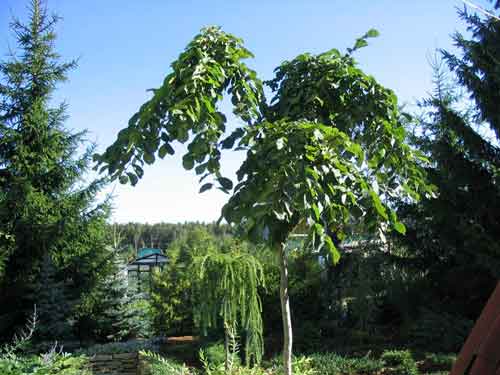

Shade-tolerant, winter-hardy. Growing rapidly. Perfectly tolerates haircuts and retains its shape. Drought-resistant, grows only on fresh, deep soils. In urban conditions, on poor soils, it grows weakly. Looks good in alley and ordinary plantings.
Decorative forms
: silver-colored; golden motley; red - with reddish foliage; cutout - with dissected foliage and grooves between them. Ornamental varieties are planted singly or in groups.
David
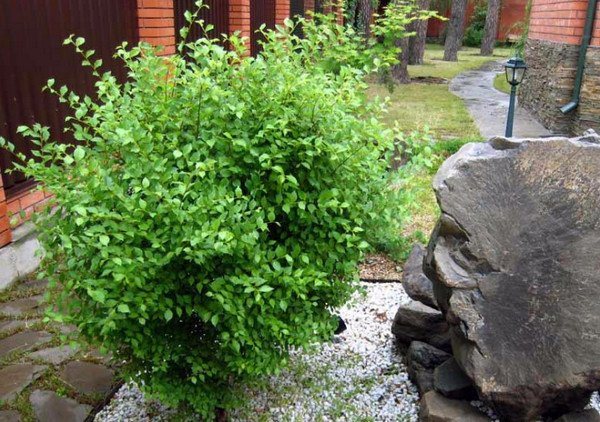

The elm of David is a bush or tree that is 15 m high. The leaves are sharp, ovoid, 10 cm long and 5 cm wide. The fruit is a yellow-brown lionfish. A well-known variety is the Japanese elm. It is popular in Russia, Mongolia, China, Japan and the Korean Peninsula.
Did you know? The long-lived elm, which is more than 800 years old, grows in Korea.
Hornbeam elm
Homeland is the European part of Russia, Kazakhstan, the Caucasus, Western Europe, Central Asia, North Africa. Hornbeam elm grows in deciduous forests.
A tree with a dense crown, and dark brown shoots. The foliage is dense, dark green, shiny, varied in shape, glabrous above, and hairy below. In the fall, it becomes yellow. The flowers of the hornbeam elm are small, reddish-red. The elm blooms before the leaves open.


Winter-hardy in the steppe and forest-steppe zones. Young shoots freeze over. Hornbeam elm is suitable for the southern regions of our country. The tree is undemanding to soil, but grows well only on moist, nutritious soil. It is well cut and keeps its shape. Forms dense hedges. Used in parks and gardens, massifs or groups in combination with other breeds.
Decorative forms differ in the structure of the crown, the color of the leaves:
Webb
- with a narrow-pyramidal crown, dark green above, ash-colored below, the leaf is rolled up like a hood;
Dampier
- with broad ovate foliage and narrow pyramidal crown;
Coopman
- a tree with an ovoid-oval crown;
Pyramidal
- with ascending branches and dark green foliage;
Weeping
- with thin, drooping branches;
Spherical
- with a rounded crown, with ovoid-elliptical leaves;
Graceful
- similar to a spherical shape, but with small branches and leaves;
Golden
- with golden foliage;
Wangutta
- with yellow foliage;
Purplish
- with small purple leaves;
Purple
- with dark purple foliage.
Garden forms are not very hardy and need sheltered places.
Large-fruited


Ilm large-fruited lives in the East of Russia, in Mongolia, China and on the Korean Peninsula. It usually grows in river valleys, on wooded and rocky slopes. Is it a shrub or small tree the maximum height of which is 11 m, with a large spreading crown. The bark is gray, brown or yellowish. The leaves are large, shiny, rough above, and smooth below.
The tree owes its name to its fruits, large hairy lionfish that adorn it. A very thermophilic plant. This species of elm differs from its relatives in its extreme resistance to drought. Therefore, it is actively used to consolidate the soil of quarries, embankments and rocky slopes.
Small-leaved or stocky elm
In the wild, it grows in Transbaikalia, the southern and middle parts of the Far East, in Japan and Korea. Small-leaved elm grows in mixed forests, on fertile soils.
A tree 15 m in height, or a shrub with a rounded crown and thin branches. Leaves are small, elliptical, leathery, unequal, with a short apex and a simple or serrated edge, smooth. In spring, the leaves of the small-leaved elm are green. Flowers are collected in bunches. Lionfish are buffy or yellow-brown.
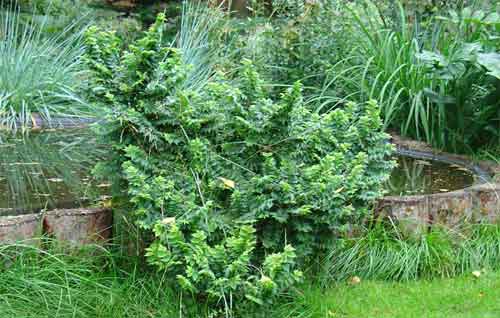

Small-leaved elm is light-requiring, undemanding to the richness of the soil. Drought-resistant, perfectly tolerates transplanting, molding, haircut. In terms of the speed of growth, the squat elm is not inferior to the ash-leaved maple and white acacia, it is more frost-hardy, it tolerates cutting and transplanting well. This type of elm has no root suckers, and this is highly valued in park construction. The small-leaved elm has a weeping shape.
Thick
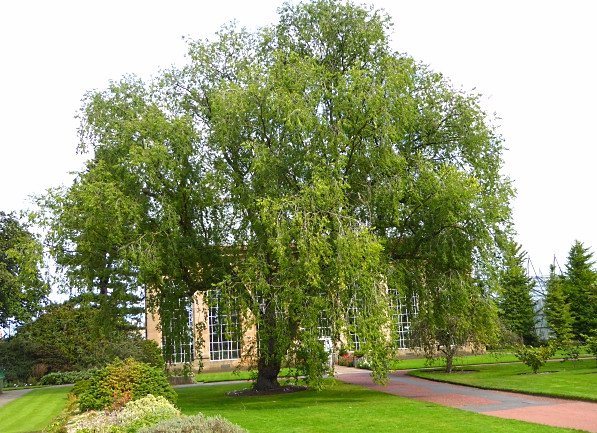

It is rare in the wild. Grows in Central Asia. This tall tree grows up to 30 m. It has a wide pyramidal crown, which gives a thick shade. The bark on young branches is yellow-brown or gray, on old ones it is dark. The leaves are small, 5-7 cm long, leathery, ovoid.
Dense elm is an unpretentious, frost-resistant plant, easily tolerates drought, although it loves moist soil. Gas resistance makes it feel great in urban smog conditions.
Rough elm
Under natural conditions, it grows in Russia, Central Europe, Scandinavia, and Asia Minor. There are in many reserves in Russia, the Caucasus, Crimea, the Baltic states. Rough elm grows in coniferous-deciduous forests, sometimes on calcareous soils.
A tree with a rounded, wide crown, reaching 35 m in height under optimal conditions. The bark on the trunk is brown, the branches are dark brown. The foliage of the rough elm is large, sharp-toothed along the edge, rough above and harsh-haired below, on short, pubescent petioles; yellowing in autumn. Flowers are collected in bunches. Flowering lasts 5-7 days. Quite large, green lionfish with a notch at the top, also in dense bunches.
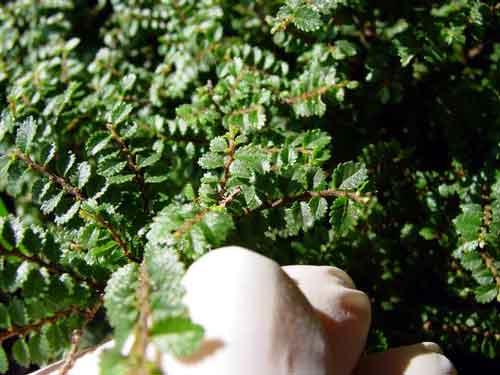

Rough elm grows quickly. Frost resistant. Perfectly tolerates urban conditions. Drought-resistant. It tolerates crown pruning. Gas resistant. The rough elm is propagated by seeds, and the decorative forms of the elm are propagated by grafting. A large tree suitable for single plantings in combination with maple, oak.
Decorative forms:
a) in the shape of the crown: pyramidal - with a narrow pyramidal crown; Camperdouna - with a rounded crown and drooping branches; weeping - with spreading main branches; low - dwarf, 2 m tall, with small foliage;
b) by the shape of the leaves: large-leaved; curly - undersized, slowly growing, with narrow leaves;
c) by coloring the leaves: yellow-variegated; yellowish purple - purple purple foliage; dark purple. An interesting form of "Lutescens" - its foliage appears creamy yellow in spring, and then turns yellow-green.
Coarse elm "Weeping" looks good on a trunk. An original tree with a hemispherical crown, similar to an inverted bowl. Long branches with large green foliage create a dense canopy under which you can hide from the sun's rays. The height of an adult tree is 5 m. It is picky about the soil. Winter-hardy, however, in cold winters, the ends of the shoots freeze slightly.
Korea, Japan, North and Central China
Sizes and forms of growth:
life form:
- 12-15 m;
- in Moscow at the age of 18 - 7 m
Elm or Ilm (Ulmus) in nature is a powerful tall tree or shrub. The genus of culture includes about 20 deciduous, rarely evergreen species that grow in temperate climatic zones of North America, Europe and Asia.
In the garden landscape, only decorative elms are in demand, which are distinguished by their unpretentiousness and long lifespan in care.
Androsov
This type of elm does not occur in nature. It is artificially bred and is a hybrid between squat and bushy elms. The height of an adult tree is 20 m. Its crown has the shape of a tent and gives a thick shade. The bark is gray. Leaves are ovoid, pointed.
Grows in moderately moist soil, easily withstands aridity. The ability to shoot sideways makes the tree a good dust collector. Therefore, it is actively used for urban plantings. The plant is easy to shape and looks very beautiful, which made it popular in landscape design.
The crown of an elm tree can serve as a "roof" for shade-loving perennials - aconite, bells, buzulnik, aquilegia, rogersia, hosta, fern, astilbe. Honeysuckle can be planted from shrubs.
Elm tree, description
Serrated leaves from 2 to 16 cm, depending on the species. They have a characteristic asymmetrical base and taper towards the top. The leaves are located on the shoots alternately, forming a dense, dense crown.
Red-purple flowers, collected in inflorescences of several pieces, appear along the shoots in March or early April. After pollination, small winged fruits are tied in place of flowers, which are carried by the wind.
The seeds of an elm that have fallen into the ground germinate in just a few days, and the tree begins to bear fruit at the age of 6-7 years.
Reproduction
In nature, elm propagation occurs by self-sowing. Seeds quickly lose their germination, so when growing an elm tree, only freshly harvested material is sown (May-June). Before planting, they are moistened for 2-3 days and treated with a fungicide. The planting depth is 1 cm, the distance between the pits is 20 cm, the top is covered with moss or hay, and watered well. Seedlings appear in a week. After the sprouts get stronger, the moss is removed, and the soil around is loosened well. Watering is reduced and stopped by mid-August. In the first year, the plants grow from seeds to 15 cm, then annually give an increase of up to 40 cm. For the winter, it is better to wrap up small plants.
Elms also reproduce vegetatively: by pneumatic shoots and root suckers. The reliability of such methods is low, so it is better to purchase a ready-made 3-4 year old seedling.
Elm seeds
Garden varieties and types of elm with a photo
Mountain elm or rough "Camperdouni" (Ulmus glabra Camperdownii). It is a picturesque low tree with a characteristic weeping crown in the form of an umbrella of hard shoots.
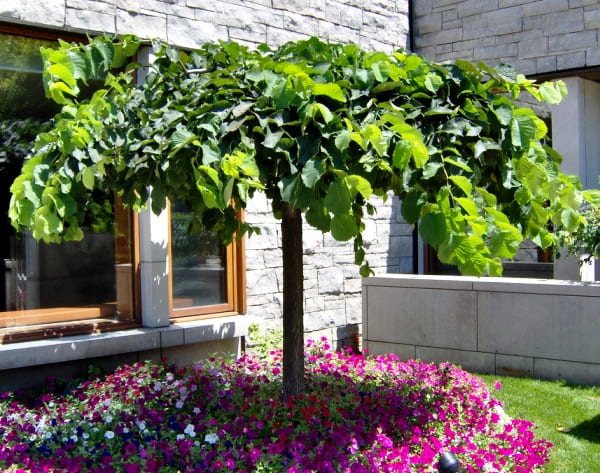

The height of "Camperdownii" is usually 2 - 2.5 m. In a few years, the crown width can reach 6 - 18 m. The leaves are large, hard, and numerous. In autumn they acquire a golden yellow color.
Weeping Elm "Pendula" with a compact crown. Another undersized variety of mountain elm with shoots forming a green tent. Trees prefer sunny locations and fertile soil.
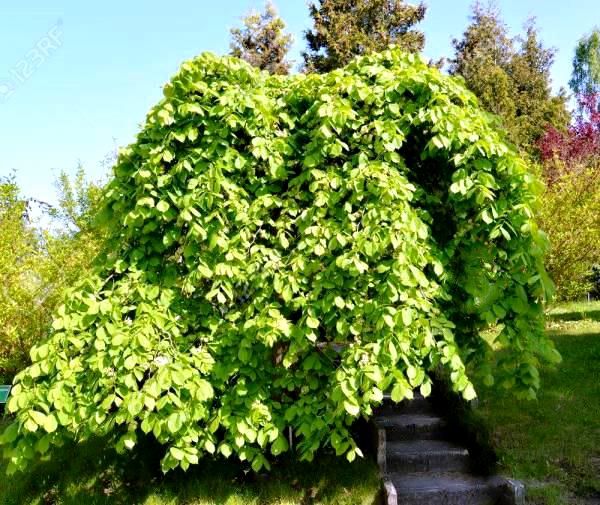

The same kind of variety from the Dutch (formerly "Monstrosa"). A rare dwarf elm, one of its smallest forms. Grows as a compact, round bush. In adulthood, its size is only 40 cm in height and 40 cm in width.
The leaves are large, about 4 cm, which is special for this small plant. The unique appearance and shape of the variety fit perfectly into the composition of low-growing shrubs, conifers and cereals.
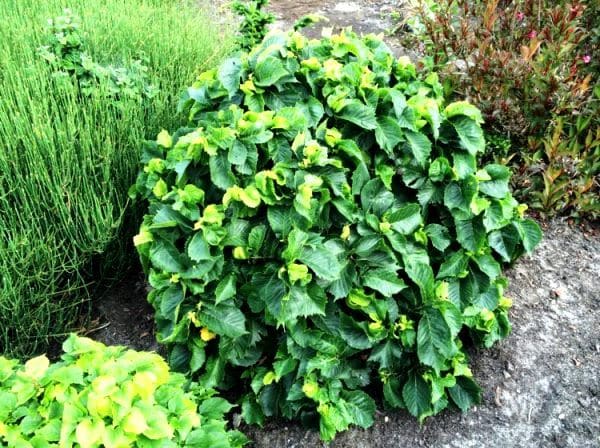

Cork elm or elm (U. Minor)Synonyms: small, field or hornbeam elm. In nature, it is a powerful long-lived tree that grows throughout Europe. Three varieties have become widespread in horticulture.
"Argenteovariegata"... The decorativeness of the elm lies in its variegated foliage with white and cream spots. It grows slowly. The height of an adult tree reaches 10 meters, and the width of the crown is 5 meters.
Typical requirements for this species are fertile, moderately moist soil, sunny location, which enhances the brightness of the foliage color.
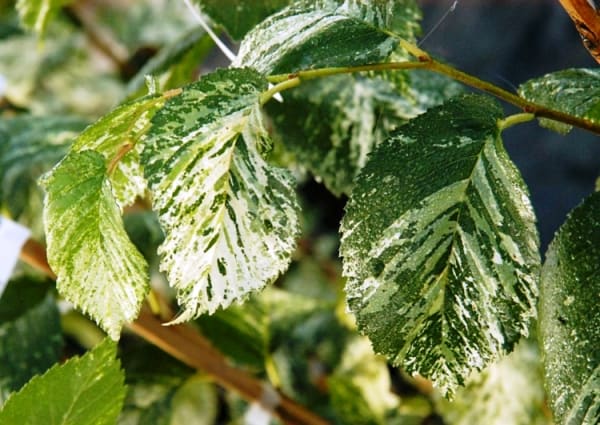

In the garden, Argenteovariegata is in perfect harmony with other variegated plants, although these original varieties are usually planted separately to create a strong accent in the garden design.
"Webbiana" - decorative elm with a unique kind of foliage. Throughout the season, the leaves of this tree are slightly curled up. It seems that the tree is drying up or sick.
Meanwhile, this is a feature of the varietal form. Produces a broad crown of several large, strong branches. The maximum height is about 4-5 meters. It grows well in moist and fertile soil, but due to the structure of the foliage, which reduces evaporation of water, the variety is resistant to prolonged drought.
The most popular and incredibly beautiful variety of this type is Jacqueline Hillier... Compact, short and slow growing tree. Its decoration is small, densely arranged, slightly twisted, dark green leaves about 2-3 cm long.
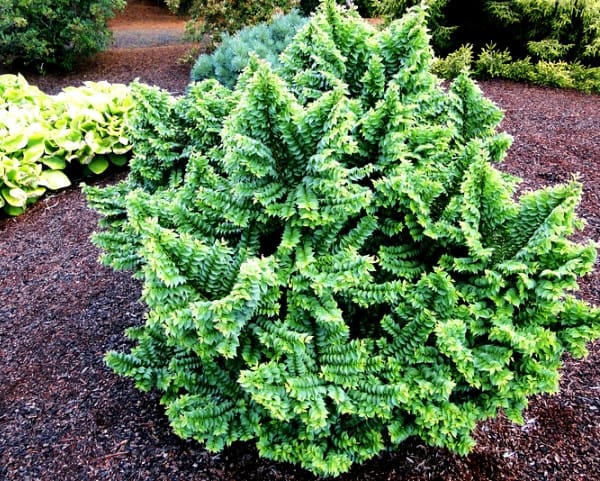

Young leaves of a pink hue. The varietal form is grown both on a trunk and in the form of a bush. It can grow in any light. The variety is resistant to diseases and low temperatures, it can grow in fertile and poor soils. After 10 years, its height reaches 1.8 m.
White or American Elm (Ulmus americana)... This tree is incredibly hardy, unlike many ornamental varieties and hybrids, it can withstand temperatures down to minus 42 ̊С! Unfortunately, this species is susceptible to Dutch disease.
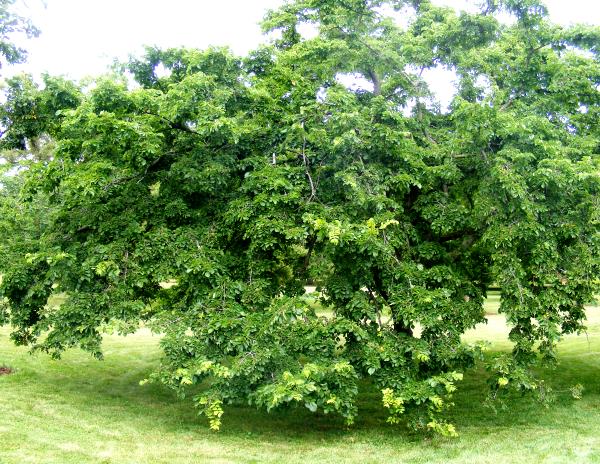

Sort "Beebes-Weeping"
The tree has a high, slightly openwork crown. An interesting fact is that the American elm does not show sensitivity to the length of the photoperiod - it will continue to grow all the time in the fall, despite the shortening days, until its growth is stopped by frost.
Squat Elm (U. Pumila) or small-leaved (Ulmus parvifolia) native to East Asia. A small evergreen shrub or tree that is ideal for creating a bonsai style. The leaves are small, in some varieties, small, shiny.
Highly decorative variety "Geisha"... In spring, the leaves are white-lime and white-cream, but after a short time they turn dark green with creamy teeth at the edges. A tree with a picturesque crown, some of the branches grow vertically, and some hang slightly to the ground, often sold on a trunk.


The variety is completely frost-hardy, although it is not recommended to plant it in places exposed to strong winds. Requires fertile, moist soils and plenty of sun, affecting bright foliage colors. The maximum height is about 3 meters. Looks great as a tapeworm near the house or on the lawn.
Hokkaido Is a dwarf Japanese variety. In eastern countries, it has gained great popularity as an excellent material for the formation of the elm bonsai. Grows in the form of a bush with a dense, branched, oval crown. Height is about 50-70 cm.
Shoots are thin, bizarrely curved, densely leafy. Thanks to the growth shape of the shoots, this tree is decorative not only during the season, but also in winter! It has a very high resistance to various types of soil, although it grows best on fertile and moderately moist soils in full sun.
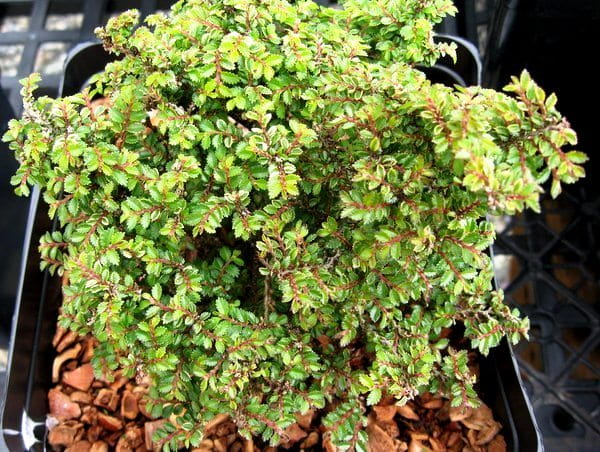

The variety is completely frost hardy, but it is better to grow it in places protected from the cold winter wind. In the garden looks great in rockeries, on alpine slides, along the paths. This planting allows you to appreciate all the advantages of the varietal form.
A very famous hybrid in horticulture - Dutch elm (Ulmus x hollandica) variety "Wredei"... A short tree with a narrow conical or cylindrical crown.
Densely leafy shoots. Leaves are wide, tight to the shoot. In spring they are light yellow, in summer they acquire a golden-green color. The shape of the leaf is slightly curled. The tree grows slowly and after 10 years it reaches 4 m in height.
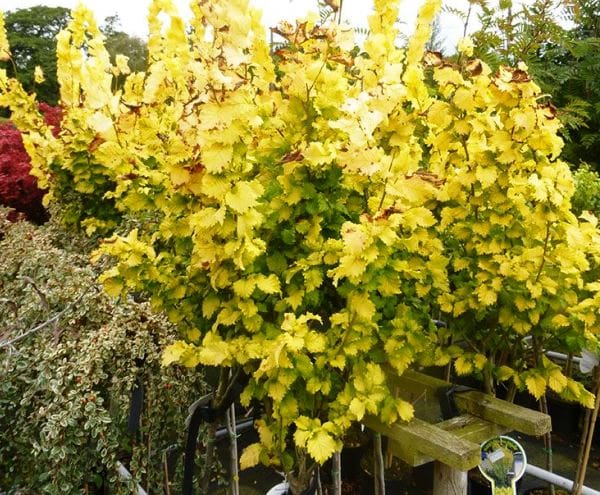

The plant has low soil requirements and is frost-resistant. The recommended variety is great for color compositions, it looks especially beautiful next to varieties of trees and bushes with green and purple foliage (barberry, elderberry, crimson).
The variety can grow in the sun and in partial shade, it is drought-resistant, but when planted in the sun requires regular watering.
Species diversity
Elms were introduced into the culture a long time ago; on the basis of some species, many varieties and hybrids have been bred, which are widely used in landscaping city streets and squares.
B. small-leaved
(lat. U. parvifolia) and V. squat (lat. U. pumila) in some places called the ilmovik (sometimes elm). In their natural environment, the species are widespread in the northern regions of China, Kazakhstan, Western Siberia, Mongolia, and India. It is cultivated in European countries, Canada and the USA. V. squat grows up to 25 m, V.small-leaved lower - up to 15 m. Leaves in both species are small - up to 8 cm long, oval with pointed tips. From the bark of these trees, a fiber similar to hemp is obtained. Karagach loves lighted places, is not picky about the composition of the soil and its moisture. Trees tolerate replanting and pruning well. In addition, they do not have root growth, which makes the species valuable for decorative use. There are varieties like 'Celer' that are great for creating hedges.
Coarse Elm "Camperdownii" in Brooklyn Park (U. glabra ‘Camperdownii’)
V. small
(lat. U. minor) or birch bark - this species, like the previous two, is called elm. The trees are relatively short (up to 10 m) and have a low crown. Cork growths can often be seen on the branches, which add value to the wood. In its natural environment, it grows in Ukraine, Asia Minor, Western Europe and in the southern regions of Russia. It differs from other species in the shape of the leaves. In elm, they are elongated, obovate with jagged edges. The species loves sunny places, not very hardy. A characteristic feature is the ability to develop a network of superficial roots, which perfectly strengthens the top layer of the soil.
V. rough
(lat. U. glabra) or V. mountain - a species that grows in nature in Asia Minor, Europe, the Caucasus and the Crimea. The species is frost-resistant (found in Karelia and in the north of Norway). Trees with a high crown grow up to 30 m. The leaves are large, up to 15 cm long. The bark is smooth. Flowering is observed in April, fruiting in May. The species is picky about the soil. Grows well in the shade. On its basis, many interesting varieties have been developed that are widely used in landscape design.
B. small-leaved (U. parvifolia)
Decorative forms of elm:
B. Mountain "Camperdouna"
(Latin U. glabra ‘Camperdownii’) is a beautiful variety with a rounded crown and drooping branches. Plants grow up to 4 m. They withstand frosts down to -30 ° C, in summer you need to make sure that the earth does not dry out.
V. mountain "Low"
(Latin U. glabra ‘Nana’) is a low-growing, slow-growing elm. The tree grows up to 2 m and has small leaves. V. mountainous "Curly" (Latin U. glabra ‘Crispa’), which also grows slowly, is similar to this variety. Of interest are the beautiful leaves with double edges.
V. rough ‘Lutescens’
(lat.U. glabra ‘Lutescens’) is a variety that has a very beautiful and delicate color of leaves. One of the few who does not have a Dutch disease of elms.
V. rough "Weeping" (U. glabra ‘Pendula’)
V. rough "Weeping"
(lat. U. glabra ‘Pendula’) - great for decorative purposes. It grows up to 5 m. The crown looks like an inverted bowl. The branches are long, hanging with large beautiful leaves.
V. small "Jacqueline Hillier"
(lat.U. minor ‘Jacqueline Hillier’) is a slow-growing variety with small leaves. Can be grown as a shrub. On sale can be found on the trunk. It grows up to 3.5 m. It develops well both in the shade and in the sun.
General rules for the care of elm
Species belonging to the genus Ulmus are usually more demanding when it comes to substrate and moisture levels. Their natural habitats are predominantly wet and fertile areas near rivers. Nevertheless, the soil must be permeable, since the elm does not tolerate stagnant water.
Young seedlings of elms after planting require regular watering, the soil should not dry out. Mature trees are watered in the absence of rain and after a snowless winter.
Poor soils are enriched with compost or humus. The land around the plantings is mulched with a thick layer of compost, bark or pebbles to avoid moisture evaporation.
Elm care includes sanitary pruning, which is carried out in early spring. Since the shoots grow very slowly, severe shortening is not recommended.
Elm pests and diseases
Ilms were once one of the most popular trees in the European landscape. Unfortunately, in the twentieth century, many of them were struck by the Dutch Elm Disease (DED).
The first symptoms of the disease are observed already at the turn of May and June, when at high temperatures the leaves begin to curl, fall off, and the stems dry out.This disease is quite aggressive, therefore, preventive or therapeutic (at the onset of the disease) treatment with Topsin M 500 SC is necessary immediately after the temperature rises above 15 ° C.
How to get rid of aphids with folk remedies - read here
The treatment is repeated after 10-14 days, trying to spray the preparation on all parts of the tree. The next treatment is repeated in the summer, and the last one is carried out in the fall. The Dutch hybrid is most susceptible to the disease, other decorative elms are more resistant.
Plantings can also be affected by viral and fungal diseases. For this reason, observation from the beginning of the growing season and preventive treatment are required.
The most famous pest is the elm leaf beetle, aphid. In the fall (October, November), preventive spraying can be carried out. For this purpose, the Promanal or Treol paraffin oil based secticides are used. The leaves are burned in autumn to prevent the spread of disease and pests.
The genus has 16 species that grow in Europe, Asia, and in the mountains of Asia.
As a rule, these are large trees with an elliptical or rounded, spreading crown; with alternate, simple, large, unequal leaves. The elm blooms before the foliage blooms. Elm flowers are small, inconspicuous. Nuts ripening 2 weeks after flowering.


Elm does not tolerate shading, but itself gives a thick shade. The growth is relatively fast. Requires fertile soil for growth, but also tolerates arid conditions.
Elm tolerates pruning well, is durable under good conditions, and is often damaged by diseases and pests. It has been used for a long time in landscaping. It has been introduced into culture since ancient times and has many garden forms.
Growing
Site selection and care
Planting an elm tree is most successful in fertile soils, especially in floodplains. Heavy soils are fertilized with organic matter. Some species tolerate soil salinity and lack of moisture well. Many elms are shade-tolerant, but there are varieties that love sunny places.
Trees are undemanding in care and cultivation, they tolerate frosty winters quite well. If the branches of the plant are slightly frozen, then it is easy to prune them in the spring. General recommendations suitable for many species are:
- fertile, well-drained soil;
- good watering in early summer, later it is reduced, but the earth is not allowed to dry out excessively.
Small elm in the form of bonsai (U. minor)
Pruning
Pruning can be done in autumn and very early spring. Elms grow slowly, so we are talking about rare and weak pruning, or none at all. Cultivars suitable for hedges are cut from mid-summer as needed. All species require sanitary pruning, which removes old and dry branches. When grown for decorative purposes, trees are formed as standard trees, leaving a bare trunk of the desired height. In addition, you can remove branches that are unevenly located along the main shoot. Weeping varieties do not form or prune.
Karagach and spruce
Smooth elm, common
It grows in Russia, the Caucasus, Western Siberia, Kazakhstan, Western Europe.
A tree with a wide, beautiful crown and hanging branches. Young shoots are light brown, fluffy, shiny. The bark is brownish brown. The foliage is round or oblong-ovate. Sharp serrate along the edge; dark green above; in autumn they are painted in brown-purple tones. Brownish, small flowers, with purple stamens. Flowering lasts about 10 days.
Shade-tolerant, winter-hardy. Growing rapidly. Perfectly tolerates haircuts and retains its shape. Drought-resistant, grows only on fresh, deep soils. In urban conditions, on poor soils, it grows weakly. Looks good in alley and ordinary plantings.
Decorative forms: silver-colored; golden motley; red - with reddish foliage; cutout - with dissected foliage and grooves between them. Ornamental varieties are planted singly or in groups.
Rough
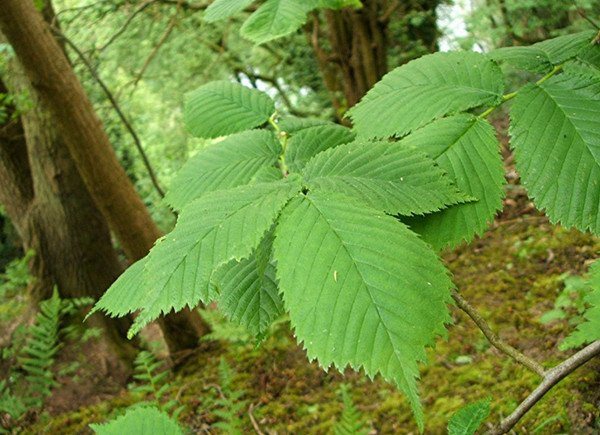

The rough elm, or mountain elm, is widespread in the northern hemisphere: Europe, North America, Asia. Grows in deciduous and mixed forests. Elm height - 30-40 m... The crown is round, wide and dense. The bark is smooth, dark brown. Large leaves (17 cm), ovoid, with sharp jagged edges. From above they are rough, and from below - coarsely hairy.


It grows quickly, lives up to 400 years. He is very picky about the soil: he loves fertile and moist, but does not tolerate saline. The elm tree tolerates frost, drought and city life freely. The wood is very hard and durable... It is used to make furniture, interior decoration materials and agricultural implements.
Did you know? The rough elm is not afraid of extreme conditions: in Norway it can be found beyond the Arctic Circle, and in the Caucasus
—
in the mountains at an altitude of 1400 m.
Hornbeam elm
Homeland is the European part of Russia, Kazakhstan, the Caucasus, Western Europe, Central Asia, North Africa. Hornbeam elm grows in deciduous forests.
A tree with a dense crown, and dark brown shoots. The foliage is dense, dark green, shiny, varied in shape, glabrous above, and hairy below. In the fall, it becomes yellow. The flowers of the hornbeam elm are small, reddish-red. The elm blooms before the leaves open.
Winter-hardy in the steppe and forest-steppe zones. Young shoots freeze over. Hornbeam elm is suitable for the southern regions of our country. The tree is undemanding to soil, but grows well only on moist, nutritious soil. It is well cut and keeps its shape. Forms dense hedges. Used in parks and gardens, massifs or groups in combination with other breeds.
Decorative forms differ in the structure of the crown, the color of the leaves:
Webb - with a narrow-pyramidal crown, dark green above, ash-colored below, the leaf is rolled up like a hood;
Dampiera - with broad ovate foliage and narrow pyramidal crown;
Coopman - a tree with an ovoid-oval crown;
Pyramidal - with ascending branches and dark green foliage;
Weeping - with thin, drooping branches;
Spherical - with a rounded crown, with ovoid-elliptical leaves;
Graceful - similar to a spherical shape, but with small branches and leaves;
Golden - with golden foliage;
Wangutta - with yellow foliage;
Purplish - with small purple leaves;
Purple - with dark purple foliage.
Garden forms are not very hardy and need sheltered places.
WHAT DOES PLANTING WORKS INCLUDE
Planting work includes the whole range of planting works: unloading plants, manually moving no more than 20 meters to the planting site, digging planting holes, adding fertile soil if necessary, moving the excavated soil along the site formed during the excavation of planting holes, to distance up to 20 m is included in the price, over 20 m from the excavation site is calculated according to a separate estimate), the introduction of chemical complex fertilizers, special chemical and organic growth stimulants (in the spring - autumn period), installation of stretch marks (if necessary), watering the plants (carried out from a watering hose with water available on the territory of the Customer). Territory cleaning after planting.
Small-leaved or stocky elm
In the wild, it grows in Transbaikalia, the southern and middle parts of the Far East, in Japan and Korea. Small-leaved elm grows in mixed forests, on fertile soils.
A tree 15 m in height, or a shrub with a rounded crown and thin branches. Leaves are small, elliptical, leathery, unequal, with a short apex and a simple or serrated edge, smooth. In spring, the leaves of the elm are green. Flowers are collected in bunches. Lionfish are buffy or yellow-brown.
Small-leaved elm is light-requiring, undemanding to the richness of the soil. Drought-resistant, perfectly tolerates transplanting, molding, haircut.In terms of the speed of growth, the squat elm is not inferior to the ash-leaved maple and white acacia, it is more frost-hardy, it tolerates cutting and transplanting well. This type of elm has no root suckers, and this is highly valued in park construction. The small-leaved elm has a weeping shape.
Paddle


Other names are split elm, or mountain. Distributed in East Asia, the Far East, Japan and China. Grows in deciduous and mixed forests. It can be found in mountain forests at an altitude of 700-2200 m above sea level. The growth of the tree is 27 m.
The color of the bark is gray and gray-brown. The crown shape is wide, cylindrical, rounded. The leaves are large, pointed from above, sometimes with 3-5 pointed lobes. The plant tolerates shade, frost, strong winds and city smoke well.
Rough elm
Under natural conditions, it grows in Russia, Central Europe, Scandinavia, and Asia Minor. There are in many reserves in Russia, the Caucasus, Crimea, the Baltic states. Rough elm grows in coniferous-deciduous forests, sometimes on calcareous soils.
A tree with a rounded, wide crown, reaching 35 m in height under optimal conditions. The bark on the trunk is brown, the branches are dark brown. The foliage of the rough elm is large, sharp-toothed along the edge, rough above and harsh-haired below, on short, pubescent petioles; yellowing in autumn. Flowers are collected in bunches. Flowering lasts 5-7 days. Quite large, green lionfish with a notch at the top, also in dense bunches.
Rough elm grows quickly. Frost resistant. Perfectly tolerates urban conditions. Drought-resistant. It tolerates crown pruning. Gas resistant. The rough elm is propagated by seeds, and the decorative forms of the elm are propagated by grafting. A large tree suitable for single plantings in combination with maple, oak.
Decorative forms:
a) in the shape of the crown: pyramidal - with a narrow pyramidal crown; Camperdouna - with a rounded crown and drooping branches; weeping - with spreading main branches; low - dwarf, 2 m tall, with small foliage;
b) by the shape of the leaves: large-leaved; curly - undersized, slowly growing, with narrow leaves;
c) by coloring the leaves: yellow-variegated; yellowish purple - purple purple foliage; dark purple. An interesting 'Lutescens' shape - its foliage appears creamy yellow in spring and then turns yellow-green.
Coarse elm "Weeping" looks good on a trunk. An original tree with a hemispherical crown, similar to an inverted bowl. Long branches with large green foliage create a dense canopy under which you can hide from the sun's rays. The height of an adult tree is 5 m. It is picky about the soil. Winter-hardy, however, in cold winters, the ends of the shoots freeze slightly.
Landscape design decoration
Elms grow quite quickly. In three to four years, a very decent tree can grow out of a small cuttings, and young plants grow by a meter annually. This rapid development makes it possible to successfully use elms in the formation of hedges. They tolerate pruning well, and thanks to rapid regeneration, their crown quickly thickens and turns into a dense array. By the way, this same property makes elm a favorite among fans of topiary.
In addition to green fences, standard or bush variants of this plant are often used in other landscape design compositions. The elm can be soloed on the lawn, it organically fits into the Japanese rock garden, harmonizes well with apple trees, felt cherries, bird cherry, or fieldfare.
Standard plants can serve as a "roof" in the shade composition. The spreading dense crown creates an excellent shelter in the shade of which you can plant ferns, bergenia, astilbe, hostu and lilies of the valley.
Lovers of harmony and color balances are probably already wondering, what does an elm look like? The crown of this plant is made up of densely growing pointed leaves, jagged along the edge and painted in a dark green color.The elm belongs to deciduous trees, but it is in no hurry to throw off the outfit, and the leaves stay on the branches until severe frosts, over time acquiring a yellowish-olive tint. Elm blooms even before the foliage appears in small flowers, collected in bunches.
Photo gallery
Small elm - Wikipedia (with comments)
This species has many names - elm, birch bark, karaich, cork elm, red elm, field elm (tree in the photo). Distribution territory: Ukraine, Russia, Asia Minor, Western Europe. It lives in deciduous and mixed forests, on river banks and high in the mountains.
The height of the tree ranges from 10 to 30 m. The crown is low. The leaves are oblong, obovate. Life expectancy up to 400 years. Karagach loves sunlit places, easily tolerates drought, but not frost. A distinctive feature is that the tree forms a wide network of superficial roots.
This strengthens the topsoil and reduces the risk of erosion. Therefore, the field elm is often used not only for landscaping cities, but also for field-protective forest plantations. Cork growths are often found on the branches, which increases the value of wood as a building material.
From Wikipedia, the free encyclopedia
K: Wikipedia: Articles without images (type: not specified)
Small elm (lat. Úlmus minor) is a species of trees from the genus Elm of the Elm family.
The plant is also called birch bark, elm, karaich, cork elm, red elm.
Lesser elm is a deciduous tree up to 30 m high and 1.5 m in diameter.
Leaves are serrated, elongated-obovate.
Flowers with a rusty-red perianth are collected in bunches. Blooms in March - April, before the leaves open. The flowers are melliferous.
Fruits (lionfish) ripen in May - June. Propagated by seeds, root suckers, shoots from the stump.
It grows in Western Europe, Asia Minor, in the north of Iran, in the south of the European part of Russia and in the Caucasus, distributed throughout Ukraine, except for the Carpathians and the extreme south.
Occurs in mixed and deciduous forests, especially on alluvial soils in river valleys; in the mountains it rises up to 1500 m.
Lives up to three hundred years. Young trees grow quickly. Photophilous, drought-resistant, but suffers from frost.
It is bred as a forest, erosion control and park breed.
Wood of this type, especially its influx, is used in mechanical engineering, in carpentry, etc.
Cultivated for landscaping, in shelter forest plantations, suitable for hedges and apiaries.
Synonyms
Synonymous names:
- Ulmus campestris auct. - Field elm
- Ulmus carpinifolia Gled. - Hornbeam elm
- Ulmus foliacea Gilib.
- Ulmus nitens moench
- Ulmus suberosa Moench - Cork elm
K: Wikipedia: Articles without sources (type: not specified) [source not specified 788 days]
Greening the city
When landscaping in cities, elm is planted as single trees (tapeworms) or in groups of 5-10 trees. In urban conditions, it develops a powerful spreading crown, which visually enlarges an already rather big tree.
In the spring (April - May), the tree attracts attention with its many flowers, the color of which is dominated by brown shades. In the summer, the elm boasts dark green leaves that effectively set off the light shells of the fruit, and in the fall, it has a golden yellow crown.
Elm is a tree that can easily be clipped and can be used as a hedge. Since about 12 species of elms grow in the territories of the post-Soviet space, within the same city you can find several different forms of it, differing from each other not only in color, but also in the shape of the leaves.
Feathery
The second name is pinnate elm. It is found naturally in Kazakhstan, the Far East, Central and East Asia. Grows on mountain slopes, pebbles, sands. Loves a lot of sun. Can live for over 100 years.Height - 15-25 m. The crown is spreading, but does not give shade.
Small leaves are arranged in 2 rows and give the impression of large feathery leaves, which gave the name to the species. The plant is winter-hardy, withstands drought freely and adapts to any soil. It grows rapidly, but reaches its maximum growth only in its natural environment: in the south, on moist soils. Easily tolerates urban conditions - asphalting, dust, smog. It lends itself well to pruning and is popular in park construction.
Root system
The root system of an elm tree is so powerful that it can compete successfully even with the roots of an oak tree. Not only the main taproot, through which the tree receives the main supply of nutrients, but also the lateral ones, go into the soil to a sufficiently large depth. It is this property that ensures the essential stability of the tree even in strong winds.
For example, when planting on field protection belts, they restrain the main gusts of wind, allowing you to get full-fledged harvests of agricultural crops, the ripened seeds of which practically do not fall to the ground.
Popular types
The following types of elm tree are described.
Hornbeam
The hornbeam elm is found in Central Asia, the Caucasus, Europe and North Africa. This is a light-loving falling tree, but it grows in the shade without any problems. Reaches a height of twenty-five meters, the maximum diameter of its crown is ten meters.
Elms have a high growth rate, tolerate pruning normally, making these trees well suited for the formation of hedges. They will look great on a manicured lawn. In appearance, they go well with bird cherry, mountain ash, as well as apple and cherry trees.
The biological description of this species is as follows. Cork growths sometimes appear on the branches of a dark brown color. The pointed leaves are large in size, smooth on top, and their underside is covered with a delicate nap. The foliage, which is dark green in summer, changes its color to bright yellow in the fall. Even before the leaves appear, small flowers are blooming, collected in bunches.
They are unpretentious and can withstand frost and drought perfectly. With growth in favorable climatic conditions, their age can be up to three hundred years. Hornbeam elm is used medicinally. It is used to prepare diuretics and antiseptics. Its bark has the ability to slow down the absorption of cholesterol. Elm bark decoction also treats burns and some skin diseases.
Hornbeam elm prefers rich, moist soil. For active, high-rate growth, it needs periodic watering and fertilization, for example, adding lime to the soil, which has a beneficial effect on the tree.
Growing recommendations:
- nutritious, moist soil is better;
- with insufficient natural moisture, trees require watering;
- periodically, elms should be fertilized with lime.
The smooth elm is also sometimes called the common and large-leaved elm. Distributed throughout Europe. It grows up to twenty, and in rare cases, up to forty meters in height. Has a wide crown with a diameter of up to twenty meters. The trunk of such an elm is straight, up to one and a half meters in diameter. The bark covering young shoots is smooth, but with age it coarsens, cracks and begins to flake off. Large leaves are pointed or ovoid. The upper side of the leaf is dark green, the lower side has a lighter shade. In autumn, the foliage changes color to brownish purple. Small brown flowers bloom in spring.
These plants are characterized by a developed root system. In mature trees, thick roots at the trunk can protrude up to half a meter above the ground. The tree grows quickly, and its lifespan can sometimes be four hundred years. Drought tolerant, but prefers moist soil. It tolerates short-term flooding without any difficulties.
Read also: Bouvardia - home care
The common elm tree has a dense, durable wood, but it is quite simple to handle. This tree is widely used in the manufacture of furniture and other joinery. Elm does not rot in water, therefore, in the Middle Ages, water pipes and supports for marinas and bridges were made from it. The bark of smooth elm has been used in leather tanning.
Karagach is also of great benefit in urban areas - its leaves can retain much more dust than other trees. Due to their extensive root system, elms are well suited for strengthening the soil on the sides of ravines and on cliffs.
Androsov's elm is an artificially obtained hybrid of stocky and dense elms. An adult tree can reach a height of twenty meters. It has a dense spherical crown, thanks to which it gives a good shade. Covered with gray bark. The leaves, like many elms, are described as ovoid or pointed.
Often grows in moist soils, but can easily tolerate droughts. Forms many side shoots, due to which it perfectly traps dust in urban conditions. The crown of this tree lends itself well to formation, which allowed the elm to become one of the most popular gardening plants.
Shade-loving perennial ornamental plants grow well under the canopy of the crown of elm:
- Aconite (Wrestler);
- Bell;
- Buzulnik Przewalski;
- Catchment;
- Saxifrage;
- Asparagus;
- Ferns;
- Astilbe.
Dense elm is rarely found in nature, mainly in Central Asia. This large tree can grow up to thirty meters in height. Its developed crown has a pyramidal shape and gives an excellent thick shade. Young branches are covered with light brown or grayish bark, which darkens over time. The leaves are medium-sized, no more than seven centimeters in length, with a characteristic ovoid shape.
This elm is unpretentious, frost and drought resistant, but grows better on moist soils. A hardy tree tolerates gas pollution well.
Lobe elm is also called split or mountain elm. Found in the Far East, including Japan and China. It is a typical wood species for deciduous and mixed forests. It can be found in mountain forests at altitudes up to two kilometers. Usually it grows no higher than thirty meters.
The tree, covered with grayish or grayish-brown bark, has a wide crown of a cylindrical or rounded shape. Large leaves are pointed at the top. Sometimes they are divided into 3-5 pointed lobes. The plant tolerates adverse environmental conditions well.
Feathery
In the regions of the Volga region, the South Urals, in the Caucasus, and in Central Asia, this tree is called - elm pinnate. Often grows on mountain slopes, pebble and sandy soils. Prefers places with high insolation. It can grow up to twenty-five meters in height. The crown is extensive, spreading, but due to the small size of the leaves, it gives a faint shadow.
Its small leaves are arranged in 2 rows, visually give the impression of large feathery leaves, which led to the name of the species. The plant tolerates cold well, easily tolerates drought and can survive on difficult soils, including saline ones. Has a high growth rate, but reaches the maximum possible growth height only in favorable conditions: in a warm climate on moist soils. It takes root and grows without problems in urban conditions. Crohn lends itself well to formation.
Distributed in the Far East, Mongolia, China, Japan and Korea. It can grow as a bush or as a tree up to fifteen meters high. It has leaves of medium size, for elms, pointed at the ends, ovoid in shape. Elm of David has a variety - "Japanese", which is sometimes distinguished as an independent species. The oldest of these elms grows in Korea and is about eight centuries old.
Lesser elm has many different names - birch bark, karaich, cork, red or field. Distribution area: Western and Eastern Europe (including the European part of Russia), Asia Minor. It is characteristic of deciduous and mixed forests along river banks and even in mountainous areas.
Depending on the conditions, the tree can have a height of ten to thirty meters. The crown starts almost from the ground. Leaves expand towards the pointed end. The life span of this tree can be up to four hundred years. Karagach prefers well-lit places, easily tolerates drought, but, unlike many species of elm, is poorly adapted to low temperatures. A distinctive feature of this species is a wide network of roots protruding above the ground.
Its root network can significantly reduce the effect of erosion. Because of this, the small elm is often used to create protective forest belts.
Large-fruited
This species is found in the Far East (including Mongolia, China and Korea). It is found on river banks and mountain slopes. It can be a shrub or tree up to eleven meters high, the crown is developed, spreading. The trunk and old branches are covered with gray, brown, sometimes yellowish bark. The foliage is large, shiny, rough above and smooth below.
The species got its name because of the large, in comparison with other elms, fruits. The species is thermophilic and does not tolerate frost well. But it has the highest drought resistance. It is actively used to secure the walls of quarries, embankments and cliffs.
Rough or mountain elm, typical of European, North American and Asian deciduous and mixed forests. It is a large tree up to forty meters high with a lush spreading crown and smooth brown bark. It has large ovoid leaves with a serrated border, covered with a hard nap below.
This species is very picky about the soil: it prefers rich and sufficiently moist, does not take root on saline soils. It is frost-resistant, easily tolerates droughts and urban conditions. The wood of the coarse elm is extremely hard.
American
His homeland is North America. It was artificially introduced to Europe in the eighteenth century, but did not gain popularity, since the local tree species have a higher value.
Often grows on the banks of rivers and lakes, but also occurs in drier areas. It grows up to thirty, rarely forty meters. The crown has a cylindrical shape, the trunk is covered with a light gray scaly bark. Elongated leaves are ovoid and medium in size. Frost resistant.
Features of elms
Elm is a tree that, when planted on fertile soil, spreads roots over a considerable distance, due to which they sometimes reach the level of occurrence of groundwater, providing the plant with nutrients even in severe drought conditions.
Elm propagates by seeds, which should be planted in the soil immediately after ripening (end of May). If planting was delayed for any reason, the seeds lose their qualities and are no longer suitable for sowing. With sufficient soil moisture, the germination process takes no more than 1 week.
Young trees grow in all directions and resemble bushes in their shape. This is due to the fact that at the initial stage of growth they do not have a vertical shoot from which the trunk is formed. However, with age, its shape evens out, and the bush becomes more and more like a tree.


It is noteworthy that a fully formed tree begins to bear fruit 10-12 years after germination.
Popular ornamental trees in the garden and in the country
The current trend in gardening is a beautiful, fruitful garden that does not require huge physical costs for the care and maintenance of decorativeness. The priority is the beauty and unpretentiousness of trees; the practical benefits of plantings fade into the background. This explains the popularity of new forms of fruit and forest trees presented by modern breeding
:
- compact standard trees
with a spherical crown; - dwarf forms
fruit and forest trees; - weeping
forms; - columnar hybrids
familiar trees.
An interesting novelty is the use of forest trees for decorating a summer cottage. For example, hornbeam seedlings are sold by nurseries at bargain prices. Hornbeam is great for creating hedges, decorative backdrops and walls.
To create spectacular compositions, lawn edging, trees of different heights are used
:
- tall (up to 6 m);
- medium-tall (up to 3 m);
- undersized and dwarf trees (up to 1.5 m).
A backdrop is formed from tall trees
(wall, or focal point), which is complemented by trees and shrubs below. From the undersized, the foreground of the composition is formed. Trees can be decorated with gravel, located on an open lawn, solo, or combined into relief, multi-tiered groups.
The tallest are planted in the background, then the middle ones. Low-growing trees and shrubs are placed in front.
Recognized leader - coniferous trees
Mature plants require little or no maintenance. Conifers are decorative all year round, including winter. In early spring, many species bloom with bright lilac candles, reminiscent of Christmas tree decorations.
... Then comes the time of active growth, the young growth is much brighter than last year's branches. During this period, all conifers look especially elegant.
Spruce grows well on swampy soils, this is especially true for the Moscow region. Pine is drought-resistant, tolerates pruning well, which allows varying height and decorative shape. For low hedges, walls, yew can be recommended
... Yew holds its shape perfectly, does not require significant pruning.
Tui
An unpretentious thuja can be safely chosen as the main decorative element of the garden, which will unite the plantings with a single idea. Thuja of different varieties will perfectly fit into a composition with undersized shrubs
, variegated and flowering trees.
In the nursery, you can pick up varieties of pyramidal, elliptical, or spherical shape
... The garden wall of thujas, planted with a smooth line, looks very interesting. This allows you to unusually beat even a standard summer cottage.
For the middle lane, varieties and hybrids of Western thuja are recommended. The unpretentious Brabant variety is suitable for the formation of a wall, backstage. A single thuja will grow wide, a close planting of a thuja (after 0.5 m) will form a too low wall
... The optimal distance between the seedlings of the Brabant variety is 1 m. An interesting variety is Wagner's thuja, which has a rounded shape, lower in growth. Tuya is very fond of shower, spraying, sprinkling.
Decorative maples
Most popular maple
Canadian, Plane, Norway maple with burgundy foliage. They are great soloists on the open lawn, are good in compositions and against the backdrop of hedges.
Maple Holly or Platanus burgundy
Like most plants with a brightly colored leaf, decorative colored maples prefer a sunny spot. In the shade, the natural color will be faded
... Maple prefers fertile soil with neutral acidity. Young seedlings should be covered for the winter. An adult plant of a frost-resistant variety will no longer require this.
Diseases
Today there are many diseases affecting elm trees, but the most common among them is the Dutch disease. It is a fungus carried by the elm bark beetle. Its spores penetrate deep into the woody structure, first weakening, and then completely destroying the tree. After infection, the leaves on young shoots begin to turn yellow and fall off.
Dutch disease poses the greatest threat to elm forests, causing them to dry out.For example, in the last century, most of all elms died from this disease in England, and now the disease has spread throughout the elm range. The most susceptible to this disease are smooth elm and birch bark, and the most resistant are small-leaved elm.
Main characteristics
Due to the flexible structure of wood fibers, many household items were woven from the obtained bast in ancient times. They were both exquisite sleighs and household utensils. Thinning of the arc and rims adorned the abode of the inhabitants of ancient Russia. At the same time, twigs and leaves were widely used for tanning leather products.
The name of this tree originates from the Celtic language, which contains a word like "Elm". The German and Latin names of the plant are also very similar - "Ulmus". The literal translation of all these words means "bending rod".
Outwardly, the elm is a mighty tree, the description and photo of which are presented below. The trunk of this representative of the elm at a young age is covered with a smooth light brown bark. As the plant grows, it becomes thick, and also rather rough and over time begins to flake off in thin plates. Deep cracks on its surface resemble battle scars. On some branches, outgrowths can form and develop.
The powerful root system of birch bark runs very deeply, so it can calmly reach the groundwater level. Due to this peculiarity of the roots, the elm grows up to 25-30 m in height, with a trunk circumference of 1.5 m. However, some species do not take root deeply, but more into the upper layers of the earth, occupying a huge area. Many members of this family can be between 200 and 300 years old.
The long-lived record holder was able to survive the fire of 1812, which occurred in Moscow. However, the sultry summer of 2010, he still could not endure and completely dried out.
How to plant and care for?
In short, an elm on a personal plot is good and healthy. How to plant it? To begin with, let us please the gardeners who fight the young shoots of apple and cherry trees every year. The elm does not reproduce due to the root system. The main way to plant it is by cuttings. You can breed elms on the site yourself - dozens of cuttings can be rooted from one adult tree and, if you wish, you can arrange a real street of elms in your country house without any nightmares. The best time for rooting is June and July.
There are no special wisdom in planting this tree, but for the first three to four days the tree needs abundant watering (up to ten liters of water per square meter), especially if the weather is hot outside. After planting, the trunk space is mulched with peat or chips with a layer of up to ten centimeters.
The active period of growth of elms occurs in the middle lane from April to October. All work on pruning and thinning the crown must be carried out even before the growing season. The exception is topiary molding, which is carried out throughout the summer.
But it's better not to rush with molding. In the early years, you will only need to remove dried and dead twigs, and start the first serious pruning around the fourth year. Most importantly, do not forget to abundantly cover all the places of the cuts with a thick garden pitch so that fungi or bacteria do not get into the wounds. In general, elm is very rarely sick, and pests do not like it, but sometimes weakened trees can become victims of a spider mite.
Last but not least, if you are involved with an elm tree, it will be for a long time. The tree is distinguished by its vitality. Individual plants of this species are known in the world, the age of which reaches 500 and even 800 years. Even indoors, elm can live for over 50 years.
Dear readers, we bring to your attention video about elm squat
:
»Trees
Gardens and summer cottages of the new wave - stylish cottages, with a comfortable recreation area for the townspeople, surrounded by a beautiful landscape. A traditional summer cottage, the main function of which is to harvest, also necessarily includes a recreation area
, lovingly decorated by the owners. It is for the spectacular design of the backyard, a beautiful lawn, a playground for children that ornamental plants and trees are needed, which are worth talking about in detail.
In addition to the natural aesthetic function - to give a person the enjoyment of the beauty of nature, ornamental trees and shrubs are used by gardeners and designers to solve purely practical problems. Visual extension of a too narrow or very small area. Decoration of outbuildings, strengthening of slopes and talus. Zoning the site, creating dividing screens between the garden and the backyard area. Protection of the individual space of a small summer cottage from prying eyes, without erecting a fence.
Quick reference
Elm is a genus of trees in the Elm family. He also has other names: elm, birch bark, elmovik or elm. There are more than 40 species of elms, most of them are found in the subzone of deciduous forests, closer to the south they can grow in spruce and coniferous forests.
They rarely grow alone, they prefer the neighborhood of other trees, and only elm forests are rarely found. On average, they live for 80-120 years, sometimes they live up to 300-400 years. In the first few years, they actively grow and develop, after 40-60 years, growth slows down and fades away.
Elms can grow up to 40 meters high and 2 meters in diameter, some species can sprout as a bush.
The root system does not have a central root: some roots penetrate deep into the soil, the rest are located closer to the surface. On podzolic soils, the roots are close to the surface.
It's important to know:
many species of elm are on the verge of extinction due to diseases and attacks of pests: leaf beetle, springtail, fungi.
Leaves are 20 cm in size, sharp, serrated edges, symmetrical. All leaves differ in shape and size, even if they originated from one shoot - this is easy to see in the photo or pictures.
Together, they form a very dense crown through which the sun does not pass. The growth of leaves begins only after the formation of fruits, while in autumn the elm is one of the first to lose its foliage.
The flowers are quite small and inconspicuous, growing and developing until the leaves appear. Occasionally, flowering can begin in the fall. The fruits ripen in April-June (the farther south the area, the faster). They are nuts with wings that are carried by the wind around the surroundings.
When it gets into wet soil, it starts growing after a few days. Southern species bear fruit from 5-10 years, northern ones - after 20 years. In addition to seeds, they can multiply by roots and shoots that appear on stumps.
The economic value of the plant is quite high:
- The wood of the tree is extremely durable, resistant to dampness and splits poorly, at the same time it easily tolerates processing and has high aesthetic qualities. It is often used in furniture business, previously used to build ships, weapons and utensils.
- Young shoots and seeds are fed to livestock.
- Paints are obtained from the bark.
- In medicine, elm is used to combat diseases of the genitourinary system and digestion, the bark is used for skin diseases.
- Elm is an excellent honey plant that bees love.
- Elm is often used for urban landscaping, since the crown does not require trimming and does an excellent job of purifying the air.
The plant easily tolerates many unfavorable conditions (drought, rains, severe frosts), which makes it an extremely popular and demanded tree in difficult urban environments. In the wild, he chooses deciduous and coniferous forests, artificially grown within the city.
Variety of wood
Twenty-meter high, with a lush green crown, a tree that loves the sun very much is called Hornbeam Elm.Elm leaves are dark green (bottle-green) and have an oblong, serrated shape with a smooth surface. The trunk is not smooth, and cork growths are noted on the branches. It blooms with a reddish inflorescence for a rather long time, after which it becomes overgrown with leaves that have a juicy yellow color in autumn. The fruiting lionfish reaches twenty millimeters. This view decorates the park area with a dense vegetation wall.
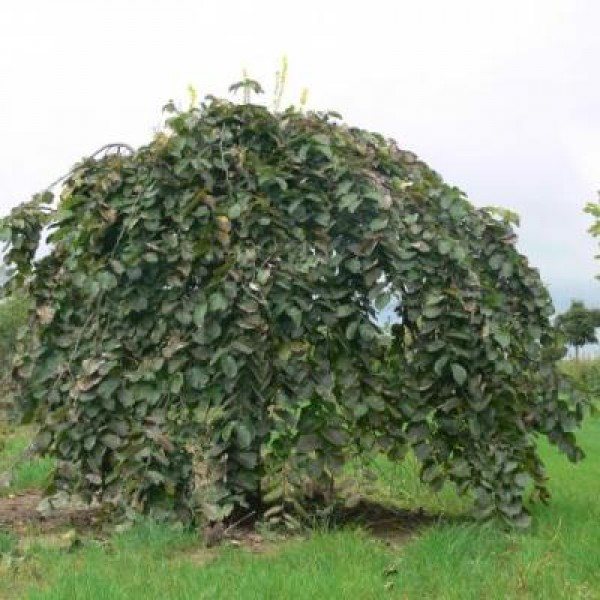

Dense elm possesses a lowered, dense crown of leathery leaves. Ilm grows up to thirty meters even in drought conditions and has dark furrowed bark.
Coniferous and deciduous forests, where there is a lot of shade, are complemented by Lobed Elm, which can withstand temperatures down to minus thirty degrees.
The wild elm, which is observed in Siberia, Kazakhstan and East Asia, is called Euonymus or Peristobranch elm, Karagach. The scorching sun in these areas does not interfere with the development of the tree on sandy and rocky soil, where the salt content is increased. A tree of this kind is about the size of a five-story house. The leaves are feathery, smooth, small and collected in delicate bunches, and the bending branches are thin. Due to the sparse crown, there is little shade from the elm, but planting a decorative tree in the squares and parks of the city, with appropriate care, pruning, can help enrich the area with oxygen and create a recreation area in the summer.
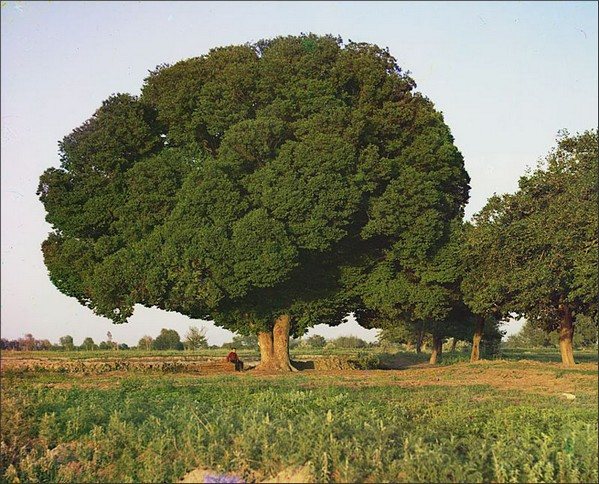

A squat elm has a rounded crown of small leaves and a small height. In urban conditions in the central part of Russia, it is possible to grow this tree, but it is difficult, since the elm is not very winter-hardy and loves fertile soil with an abundance of moisture.
Of the elm variety, they are also noted such as:
- Japanese elm or birch bark;
- Mountain or rough elm;
- Elm Androsov;
- English elm.
Trees differ in size, flowering period, shape and structure of leaves, flowers, stem bark, fruiting cycle, as well as soil and weather resistance.
The described types of elm can help in choosing a plant to plant for decorative purposes.
The virtues of the elm
What other advantages does an elm have? It is frost-resistant, does not suffer from frost, tolerates dry air and drought well, as well as soil salinity. Shadelover.
Although the elm prefers to live on good, deep and loose soils, nevertheless the above signs make it a xerophyte tree (for more details: Xerophytes and hydrophytes). Therefore, it is an irreplaceable breed, like maple, in steppe afforestation, and in field protection belts it is used as an accompanying breed. Due to its shade tolerance, it is a good fur coat for the main species, for example, oak.
In the past, elm was used in steppe afforestation and as the main species.
Features of the growth of an elm
What other features does elm still have? These features are related to the growth of an elm tree. The fact is that both seedlings and young elm trees grow quickly and give an increase of up to one meter per year. But after 12-15 years, his growth begins to slow down. When the elm turns 40-50 years old, it grows very unimportantly, and by the age of 80-100 its growth stops altogether.
The wood of the elm tree is strong, viscous, resilient, relatively light, widely used in the furniture industry, carriage building.
Pure elm groves are rare. As a rule, it is part of broadleaf oak forests.
Small-leaved elm
Small-leaved (or squat) elm in natural conditions is widespread on the islands of Japan, northern Mongolia, eastern Kazakhstan, the Far East and Transbaikalia of Russia. It is also successfully cultivated in North America and Southern Europe. Mature trees of this species are insignificant and barely reach 15 meters, and the trunk diameter is no more than a meter.
The small-leaved elm is very light-loving and unpretentious to the soil, it also tolerates frost and drought very well. Due to such biological features, it is successfully used in field-protective forest belts and for the restoration of forest resources.
Origin story
Smooth elm, or ordinary, is one of the representatives of the elm genus. This genus of deciduous trees is very ancient, it is more than 40 million years old. In the wild, all representatives of the genus grow in deciduous forests, sometimes found in spruce forests.
The cultivation of the plant happened relatively recently, three centuries ago. From that moment on, smooth elm began to be used to decorate park alleys.
It is believed that the Latin name for the elm genus, Úlmus, comes from the Celtic word "elm" - as this people called this tree. The Russian word "elm" appeared, most likely, due to the fact that the wood of the plant is very flexible (viscous).


Planting and leaving
It is not difficult to breed an elm in a personal plot. Moreover, this can be done by seeds, since they sprout very rapidly - within a few days. The only drawback is that germination is quickly lost, so you should not miss the moment.
- The seeds collected from the tree after flowering are placed in a moist nutrient substrate for several days. You can just put them on wet cotton wool. The embryos are immediately treated with a fungicide, otherwise the fungus that appears will be impossible to destroy.
- After 2-3 days, the germinated seeds are planted in a container with soil. It is better to use black soil for these purposes so that the plant develops faster. In the absence of nutrient soil, a mixture of humus and leafy soil is suitable. The soil must be loose and well moistened.
- The seeds are deepened by 1–2 cm, making the distance between plantings about 25 cm. The top layer of soil is covered with moss, hay or cotton wool. The earth needs to be moistened daily. After 10 days, it will be possible to observe the young shoots and remove the covering material.
It is useful to expose sprouts to the sun more often. Since elm seeds ripen in April-May, their germination period falls on the end of spring - the beginning of active vegetation of most plants. In clear and dry weather, it is better to leave the container with shoots in the open air: on the balcony, in the garden.
In the first year, elm shoots rise up to 20 cm, in the second, they can be planted in open ground. Similarly, in spring or autumn, ready-made cuttings or purchased seedlings are planted.
Young elms are not capricious, undemanding to the composition of the soil, temperature conditions or moisture. However, in the early years, they must be protected from strong winds and frosts, wrapping them up for the winter with special agrofibre. It is worth remembering that the nutritional value of the soil directly affects the growth rate of trees, so it is advisable to periodically fertilize scanty soils with organic matter. It is also necessary to ensure that the soil around the roots is always well loosened.
In hot weather, additional watering will have to be introduced; with regular rains, even young shoots in the open field do not need special moisture.
For a year, elms grow by 40-50 cm. Pruning of branches in the first years is usually not done, allowing the crown to grow properly. Only dried or diseased branches are removed. As the trees mature, the greenery can be tamed, giving it an aesthetic appearance.
Of the elm pests, the most common are the elm springtail, scale insects, and leaf beetles. In diseased plants, foliage and branches dry quickly, the bark becomes covered with painful growths. You can fight pests using traditional methods: spraying trees with a solution of copper sulfate and other insecticides and fungicides. Young trees can be easily removed from pests; adult specimens are much more difficult to cure. It is especially difficult for trees to tolerate fungal damage, for this reason, fungicides should be used as a prophylaxis even at the planting stage.
Planting elms is a great way to plant garden areas, squares, country and urban landscapes. These trees perfectly tolerate the effects of a gassed atmosphere, cleanse the air from dust particles, soot and smoke, and create a picturesque street landscape.They are usually planted along roads, along river banks, at the edge of ravines in order to strengthen the soil and prevent landslides.
Elena Golets03 July 2019 4473
The elm belongs to the elm family. There are 10 types of elm. The most important we have is the common elm. Here is a description of the elm tree.


American
From the name it is clear that the homeland of this species is North America, where it is widespread. This elm was introduced to Europe in the 18th century, but did not become popular, since the local species have more valuable characteristics.
Ilm American grows in forests along river banks, but you can also find it in dry places. Plant height - 20-30 m, sometimes 40 m. The crown is wide, cylindrical. The bark is light gray, with scales. Leaves are elongated, ovoid, 5-10 cm in length. Withstands frost well. Life expectancy is 200 years.
Such a variety of elm species with different characteristics allows you to choose exactly the tree that is suitable for your personal plot.
Diseases and pests
The smooth elm is an unpretentious tree that is resistant to most diseases. His only enemy, which is almost impossible to cope with, is the Dutch disease. It is caused by a fungus that is carried by bark beetles. Getting on the plant, the fungus interferes with the normal circulation of sap along the trunk and branches.


As a result, the leaves begin to curl, the growth of the plant gradually slows down. Growth disorders are manifested in the untimely appearance and loss of foliage. After a while, the diseased tree dies.
This disease worries botanists in more than one country, since because of it the number of elms is rapidly decreasing, and there are still no effective methods of combating the disease. If an infected tree is found, it must be urgently destroyed along with the pests that carry the fungus.
Another attack is the shield. It is a tiny insect that looks like a flat bug. It is extremely difficult to notice it on a tree, since at first glance it may seem that the trunk is covered with growths. It is possible to determine that the plant is infected only by the foliage - it becomes covered with white or yellow spots. A diseased tree should be uprooted and burned immediately.
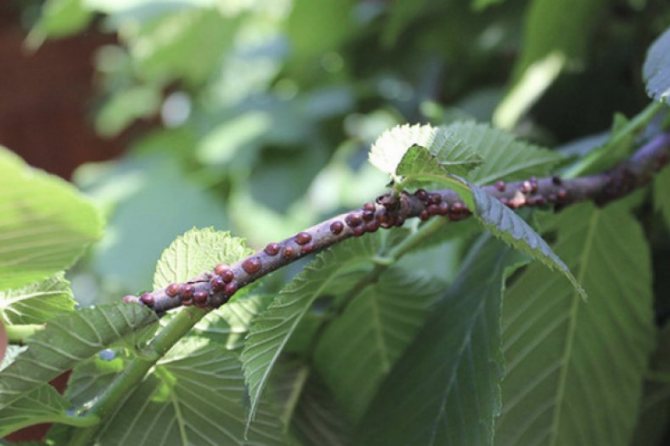

Exotic for lovers
Magnolia
It can be formed as a bush, but a full-fledged tree with a picturesque crown can grow. Blooming magnolia is an exotic sight, most varieties have a delicate, vanilla-citrus aroma
... Magnolia is covered with large flowers (bud length up to 12-15 cm). The color scale and shape of the opened flower differs very radically in different varieties of magnolia.
The whimsicality of magnolia is greatly exaggerated; for successful cultivation, it is enough to follow a few rules. When planting magnolias, special attention should be paid to the root system and the choice of planting site. It is necessary to buy magnolia with a root ball (in a plastic container), preferably in a nursery or garden center. When planting, try not to injure the roots of the seedling. Magnolia is very fond of the bright sun, does not tolerate drafts and winds. The optimal landing site is under the southern wall of the house, any outbuilding. He does not like calcareous soils, so such lands must be acidified with peat. There is no need to care for an adult plant, only minimal sanitary pruning. For growing in gardens of the middle lane, deciduous forms of magnolia, and the corresponding hybrids are recommended.
Young seedlings, even frost-resistant varieties, should be covered for the winter (mulch the roots and cover the crown with agrofibre).
Sakura
The Japanese relative of the familiar cherry, is famous all over the world for its magical flowering. The growing conditions for sakura and magnolia are identical. A sunny place without drafts; neutral or slightly acidic soil
... Like ordinary cherries, sakura will need seasonal spraying from pests, abundant watering, and significant pruning.
Sakura does not have to be bought, it reproduces well by cuttings
... It is much cheaper than buying a seedling. In August, the stalk is grafted onto a traditional cherry (or sweet cherry) by budding method (with an eye, a kidney).
Decorative forms of fruit trees
The apple tree familiar to everyone has many decorative subspecies that bloom more abundantly than simple apple trees. Blooming with scarlet flowers, Ola's apple tree is simply flooded with flowers so that you cannot see the branches
.
Ola apple blossom
Ornamental varieties are grown in the usual agricultural technique, familiar to gardeners for caring for traditional apple trees. Fruits - small (heavenly) apples adorn the garden until late autumn
... Yellow, red, purple - look great on the branches. They attract birds to the garden, this is a modern option for a natural solution to the pest problem. From heavenly apples, an original jam is obtained. Particularly interesting are weeping forms, with a variegated and colored leaf.
Interesting novelty: columnar fruit trees
The compact, productive trees, strewn with fruits of the usual size, have fascinated many gardeners. Columns bear fruit in the second year, take up little space, and are easy to care for
... The lifespan of such a tree is up to 15 years, in contrast to the usual longevity of ordinary trees of fruit and stone fruit crops.
What are the columnar trees
Columnar apple - undersized, dwarf (relative to the standard) standard tree
... Proven, high-quality varieties - Arbat (medium-ripening red apple), Bolero (winter), Gin (summer variety).
On sale are seedlings of columnar trees of the latest selection
: plums, cherry plums, pears, peaches. The main problem is the instability of the variety. Dying off of the lower branches, changes in the shape of the crown (formation of a "broom"), freezing of growth buds, degeneration of the variety. Sellers are outright fraudulent. If you decide to grow columns, buy adapted seedlings from proven regional nurseries.
At the moment, only the columnar apple tree boasts a large number of resistant varieties. The rest of the columnar novelties can be purchased only at your own peril and risk.
Features of planting and caring for fruit fruit trees
Columns are very comfortable for handling and maintenance, organizing drip or spot irrigation. The growth of an adult fruit tree is about 1.5 m, it is grown in the usual agricultural technology, like ordinary fruit and stone fruit trees
... Depending on the variety, seedlings are planted at a distance of 0.4 - 0.7 m from each other. The distance between the rows is 2 - 2.5 m. You will need seasonal pruning, pest control, top dressing, loosening of the root circle.
After planting a one-year-old seedling, the plant will show its variety in the first year. To do this, leave 2-3 flower ovaries on the tree, it is better to remove the rest of the flowers in the first year
... The seedling needs strength to adapt to a new place, to form a healthy root system.
Selection does not stand still, popular varieties are constantly being improved
... Whether experimenting with original novelties, or choosing a decorative variety that has been proven over the years, this is a constant temptation for the gardener. Based on your taste preferences, you can choose an original decoration for your favorite garden.
Korea, Japan, North and Central China
Sizes and forms of growth:
life form:
wood
deciduous
monoecious
- 12-15 m;
- in Moscow at the age of 18 - 7 m
crown shape:
thick, tent-shaped
root system:
does not give root suckers
Life Expectancy:
Growth rate:
- grows rapidly up to 60-80 years of age;
- average growth rate in Moscow
The soil:
pH:
mechanical composition of the soil:
loams, light soils
Planting and reproduction:
optimal landing dates:
spring, autumn
transfer:
tolerates transplantation well
breeding methods:
seeds, green cuttings, grafting
features of seed reproduction:
seeds need stratification at + 5 ° С for 2-3 months
vegetative propagation:
grafting and grafting on different types of elms
Care:
A haircut:
tolerates haircut well
Winter hardiness:
main view:
medium (up to -28 degrees)
winter hardiness zone
Decorativeness:
Decorative season:
Spring Summer Autumn
Decorative properties:
leaves
Branches (bark color, shape):
branches are thin, pubescent
Leaves:
- alternate, elliptical, ovate or obovate, 2-5 cm long, acute or obtuse, with an unequal base, dentate along the edge, smooth and shiny above, pubescent below, almost leathery at maturity, on petioles 2-6 mm long;
- in mild climates, leaves do not shed for the winter, in cold climates - leaves stay on the tree for a long time
Summer color of leaves (needles):
dark green, paler below
Autumn color of leaves (needles):
red or purple
Flowering time:
- Aug. Sept;
- does not bloom in Moscow
Flowers:
Inflorescences:
small bundles
Fruit:
yellow-brown lionfish
First date with an elm tree
Looking at the photos of the leaves and seeds of the elm tree, you can notice some unique features of their structure. With this research, the grower will not confuse it with other varieties. These slender giants have:
- Small nondescript flowers of a purple hue. The lush inflorescences are adorned with many purple stamens. In combination with soft green legs, they look special. The flowering period of the plant is 10 days. Basically, it will fall in March or April.
- Large leaves. On the stem, they are located alternately. The length of each varies from 12 to 15 cm. The pointed conical shape of the leaves is in harmony with the ribbed surface. The pronounced side veins create a relief texture on the dark green canvas. The upper part of the leaves is smooth, but the lower one is covered with a fluffy layer of villi. It is on them that all the dust accumulates. In the autumn, they acquire an amazing color in a yellow-red color scheme.
- Young shoots. They grow in the lower part of the trunk, forming bulky tubers. Light brown young stems have a smooth texture.
- Fruit. Each of them resembles a thin plate - a lionfish - in the center of which a grain is hidden. There is a subtle notch at the top of the wing. They are planted on short cuttings and collected in dense bunches. However, the tree begins to bear fruit at the age of seven or eight. By the end of May or the beginning of June, the seeds are fully ripe.
Smooth elm is the most popular elm variety. It is found in many city parks. This species perfectly tolerates severe winters and can withstand temperatures down to –28 ° С. But still, the shoots of the plant may freeze a little. Of the 16 popular varieties, half can be found on the Scandinavian Peninsula, as well as in Europe. If you analyze where the elm tree grows in Russia, you will notice that these are mainly wet regions, such as:
- Western Siberia;
- Volga region;
- South Ural (Chelyabinsk and Sverdlovsk regions);
- Kazakhstan;
- Caucasus.
Ilm gets along well not only in a humid environment, but also in a dry climate, since it penetrates with its roots to underground springs. The banks of rivers and lakes, as well as deciduous forests, are their favorite habitats. Still, very compacted and saline soils negatively affect the life of the tree, although elm is unpretentious in the choice of soil.
Birch bark grows incredibly fast. The annual growth of both a young seedling and an adult tree is 0.5 meters in height and 0.3 m in width.
Breeding
Elms reproduce by self-sowing. Their seeds ripen in May-June and lose their germination in a short time. Therefore, only freshly harvested material will be suitable for planting. In nature, they can also reproduce by shoots and root suckers, but for amateur nurseries, such methods are ineffective when breeding trees.
It is recommended to store elm seeds under good ventilation for no more than one week until sowing.A couple of days before planting, they are moistened and treated with a fungicide. Planting sites do not need preliminary preparation, but some mineral fertilizers can be added to the soil. Seeds are sown in rows at a distance of 20-30 cm between the pits in a shallow depth - only 1 cm.
Elm family
Ilm (Ulmus) is a genus of large trees and shrubs, most of which throw off their leaves for the winter. The most famous species are large trees with coarse, thick bark, which are deeply cracked. Cork growths can develop on the branches of most southern trees.
The root system is very strong. Individual roots can go so deep that they often reach the level of groundwater flow, and the mass lies in close proximity to the surface. Knowing what an elm looks like, you can easily distinguish it from other trees in nature.
The leaves are pointed, with many denticles and drooping stipules. The flowers are rather inconspicuous. Depending on the type of elm, they can be collected in bunches or capitate inflorescences. Pollination is mainly due to wind. As a result of a long process, a single-seeded fruit in a thin shell is tied on the tree, often additionally protected by a lionfish.
Meaning and application
Young shoots serve as branch feed for livestock (leaves and tree bark).
Elms play an important role in the greening of cities and villages, are widely used for landscaping streets, gardens and parks, for casing roads, as well as in protective forest plantations. They are the main park species in Europe, North America and the middle and southern regions of the European part of Russia. They tolerate pruning well and keep the created shape for a long time, are used in sheared structures. However, elm plantations in the steppes are often unstable and suffer greatly from pests.
Bast - of low quality, is used for roofing, making boxes and covering sleds.
Bark - for tanning and dyes.
Wood
The property of elm wood to resist rotting under constant dampness was used in medieval Europe, where water pipes were made from hollowed out elm trunks. Elm wood was also used to build the pillars of the first London Bridge. However, this resistance to decay in water is lost upon contact with soil.
Elm wood with a dark brown core and lighter sapwood, ring-vascular with a characteristic pattern in the form of parallel or broken-tangential stripes; the medullary rays are narrow. The wood is strong, hard, resilient, viscous, it is difficult to prick, it lends itself well to processing. The density of dry elm wood varies depending on the species and averages 560 kg per m³. It is widely used in the furniture industry, carpentry and machine-building industries. The influx of elm is especially appreciated, which gives a beautiful pattern when sawing.
Elm wood has a high calorific value.
origin of name
The elm tree, a photo and description of which is presented in this article, is a member of the elm genus. The modern name comes from the Celtic name "elm", which later spread throughout the world, having undergone minor changes. So, in German, these trees are known under the name "Ulme", and in Russia each individual species of elm received its own name.
It is noteworthy that the most famous of them is the elm. Literally the word is translated as "flexible rod", which fully corresponds to the structure of this tree.
Hornbeam
This type of elm (tree and leaves in the photo) is found in Europe, Central Asia, North Africa, and the Caucasus. A deciduous tree that likes well-lit areas, although it grows in the shade. The maximum height is 20-25 m, and the crown diameter is 10 m.
There are cork growths on the dark brown branches. The leaves are large, pointed, smooth above, and hairy below.The foliage is dark green in summer and bright yellow in autumn. Small flowers, collected in bunches, bloom until the leaves appear. The fruits are nuts inside the membranous lionfish.
It tolerates cold winters and droughts well. In favorable conditions, it can live for 300 years. Hornbeam elm is good for your health. It has diuretic, antimicrobial, diuretic and astringent properties. The bark inhibits the absorption of cholesterol. A decoction from it heals burns and skin diseases.
Features of breeding and care
Many people know about the medicinal properties of the bark, leaves and fruits of the elm, so they want to have this luxury in their garden. Due to the diuretic and astringent action of these natural components, it is used in the treatment of:
- gastrointestinal tract;
- skin diseases;
- swelling;
- rheumatism.
The extract obtained from the bark is used as an anti-inflammatory or antibacterial agent. Moreover, these trees create a cozy atmosphere in the backyard. They "love" a haircut, so it is easy to create a hedge out of them.
In this case, it is important to adhere to the basic rules for planting elm seeds. As soon as they are ripe, they must be immediately planted in the ground. The first two weeks is the optimal period for this. If you wait a little, then they lose their properties. Although the seeds do not require preliminary preparation, they must be sown correctly. This requires:
- dig up the garden well;
- apply mineral fertilizers;
- make the distance between the rows from one to two meters;
- sow grains in increments of 30-50 cm;
- cover a small hole with a thin layer of soil;
- water abundantly.
You can also plant it in the shade. Nevertheless, on a lawn well warmed by the sun, it will grow several times faster. The crown of an elm tree expands very quickly, which can negatively affect neighboring light-loving plants. Among other things, since ancient times they have a mutual intolerance with grapes.
It should be noted that June can surprise with its hot weather. Therefore, the planted area must be covered with foil until shoots appear. For about a month, young sprouts should be watered abundantly.
A perennial problem in the elm tree is Dutch disease. If there are many dried / unblown branches on it, peeling bark and at the same time the crown has a poor appearance, it means that the birch bark is affected by this disease. The main reason for its occurrence is excessively moist soil. It can get sick in this way from several weeks to 5-7 years. Therefore, you need to monitor the level of moisture in the soil so that lush thickets always decorate the garden.

